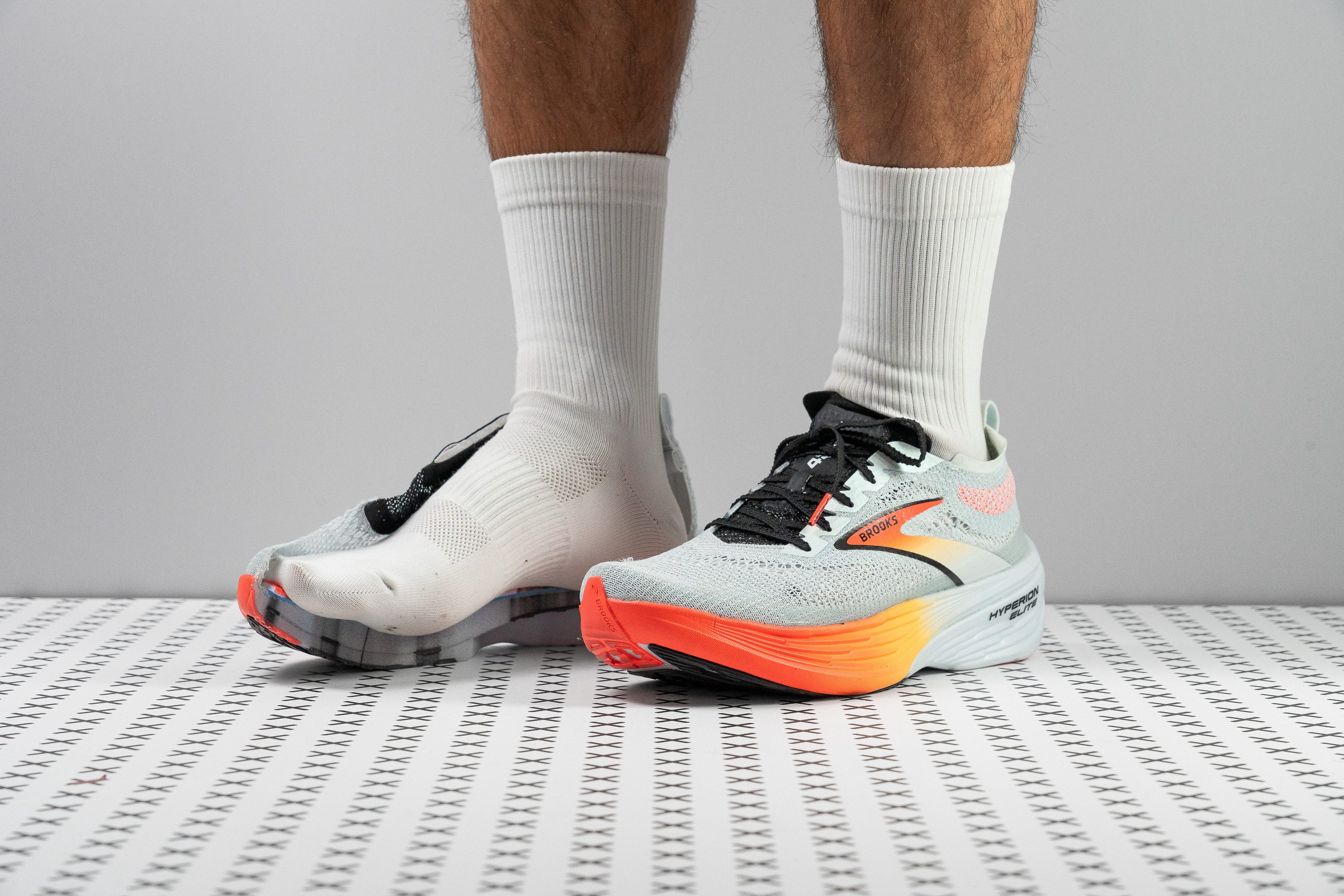Our verdict
Pros
- World-class upper
- Cushioned to legal limit
- Personalised carbon plate
- Good stability
- Notched laces
- Durable outsole
- Less extreme than other racing shoes
- Superior build quality
Cons
- Narrow toebox and heel
- Foam lacks energy return
- Excessive weight for a racing shoe
- It's not a real supershoe!
Audience verdict
Comparison
The most similar running shoes compared
+ + Add a shoe | |||||
|---|---|---|---|---|---|
| Audience score | 87 Great! | 91 Superb! | 87 Great! | 90 Superb! | |
| Price | £250 | £270 | £230 | £290 | |
| Pace | CompetitionTempo | Competition | Competition | Competition | |
| Shock absorption | High | High | High | High | |
| Energy return | Moderate | High | High | High | |
| Traction | High | High | High | Moderate | |
| Arch support | Neutral | Neutral | Neutral | Neutral | |
| Weight lab Weight brand | 7.8 oz / 220g 7.8 oz / 221g | 7.2 oz / 204g 7.1 oz / 201g | 7.8 oz / 220g 7.7 oz / 218g | 7.9 oz / 225g 7.5 oz / 212g | |
| Lightweight | ✓ | ✓ | ✓ | ✓ | |
| Drop lab Drop brand | 11.8 mm 8.0 mm | 11.2 mm 8.0 mm | 9.5 mm 8.0 mm | 10.2 mm 9.0 mm | |
| Strike pattern | Heel | Heel | HeelMid/forefoot | Heel | |
| Size | True to size | - | True to size | True to size | |
| Midsole softness | Balanced | Soft | Balanced | Balanced | |
| Difference in midsole softness in cold | Small | Small | Small | Small | |
| Toebox durability | Decent | Decent | Good | Decent | |
| Heel padding durability | Good | Good | Good | Decent | |
| Outsole durability | Good | Bad | Good | Decent | |
| Breathability | Breathable | Breathable | Breathable | Breathable | |
| Width / fit | Narrow | Narrow | Medium | Narrow | |
| Toebox width | Medium | Medium | Medium | Narrow | |
| Stiffness | Stiff | Stiff | Stiff | Stiff | |
| Torsional rigidity | Stiff | Stiff | Stiff | Stiff | |
| Heel counter stiffness | Flexible | Flexible | Flexible | Flexible | |
| Plate | Carbon plate | Carbon plate | Carbon plate | Carbon plate | |
| Rocker | ✓ | ✓ | ✓ | ✓ | |
| Heel lab Heel brand | 39.1 mm 40.0 mm | 37.6 mm 40.0 mm | 38.1 mm 40.0 mm | 38.6 mm 37.0 mm | |
| Forefoot lab Forefoot brand | 27.3 mm 32.0 mm | 26.4 mm 32.0 mm | 28.6 mm 32.0 mm | 28.4 mm 28.0 mm | |
| Widths available | Normal | Normal | Normal | Normal | |
| Orthotic friendly | ✓ | ✓ | ✓ | ✓ | |
| Season | SummerAll seasons | SummerAll seasons | SummerAll seasons | SummerAll seasons | |
| Removable insole | ✓ | ✓ | ✓ | ✓ | |
| Ranking | #298 Top 45% | #27 Top 8% | #145 Top 39% | #72 Top 20% | |
| Popularity | #306 Top 47% | #119 Top 32% | #33 Top 9% | #248 Bottom 33% |
Who should buy
We've rigorously tested the Hyperion Elite 4 and confidently recommend it for:
- Those with narrow feet looking for a carbon-plated shoe with a gentler ride than typical supershoes.
- Brooks aficionados desiring the premier racing shoe from their beloved brand.
- Marathoners who heel strike and want a durable outsole in their racing footwear.
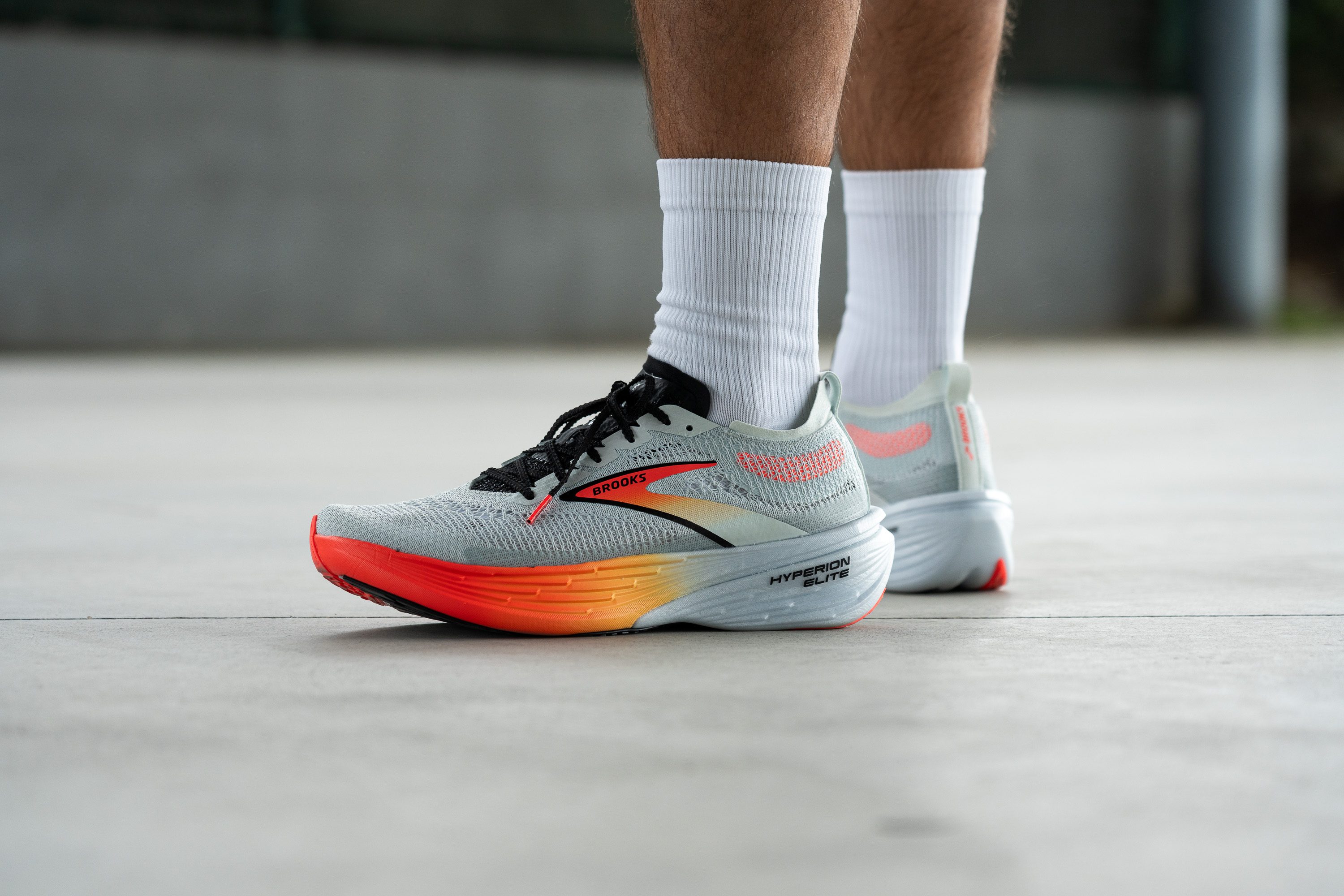
Who should NOT buy
The Hyperion Elite 4 lacks the world-class foam typical of top supershoes, and its energy return significantly trails behind. Thus, we do not recommend it for runners aiming to shave seconds off their race times. Instead, we suggest the Hoka Rocket X 2 or the Saucony Endorphin Pro 4 as superior alternatives with PEBA midsoles.
Additionally, the Hyperion Elite 4 needs to shed some weight—it's noticeably heavier compared to its competitors. For those seeking the ultimate featherweight experience in their next race, we think the Nike Vaporfly 3 or the Saucony Endorphin Elite are better choices.
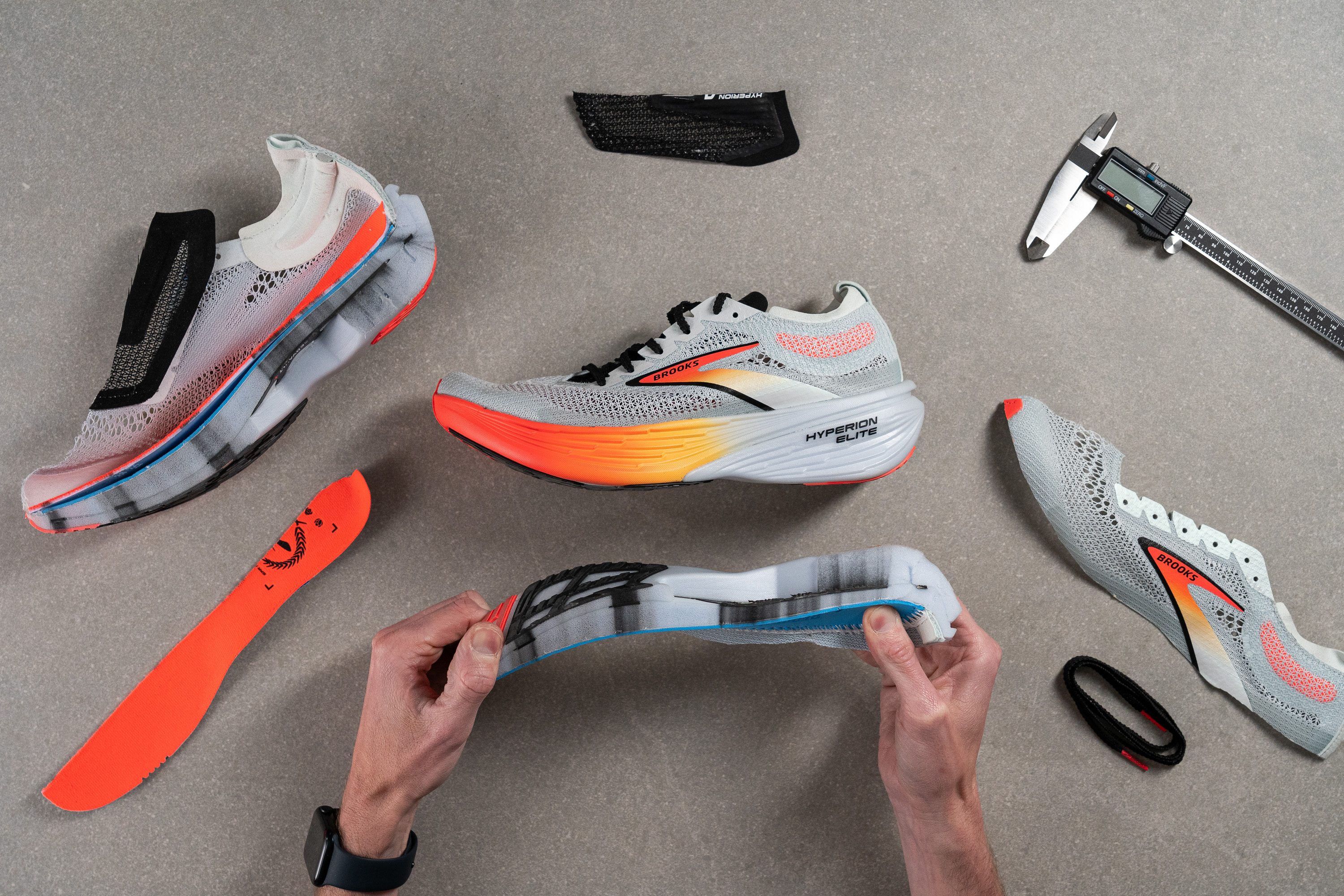
Cushioning
Shock absorption
The Hyperion Elite 4 cushions each landing effortlessly, offering impact protection suited for marathon distances or ultra-long runs. In our lab test, we measured a solid 137 SA, proof of its massive stack height.
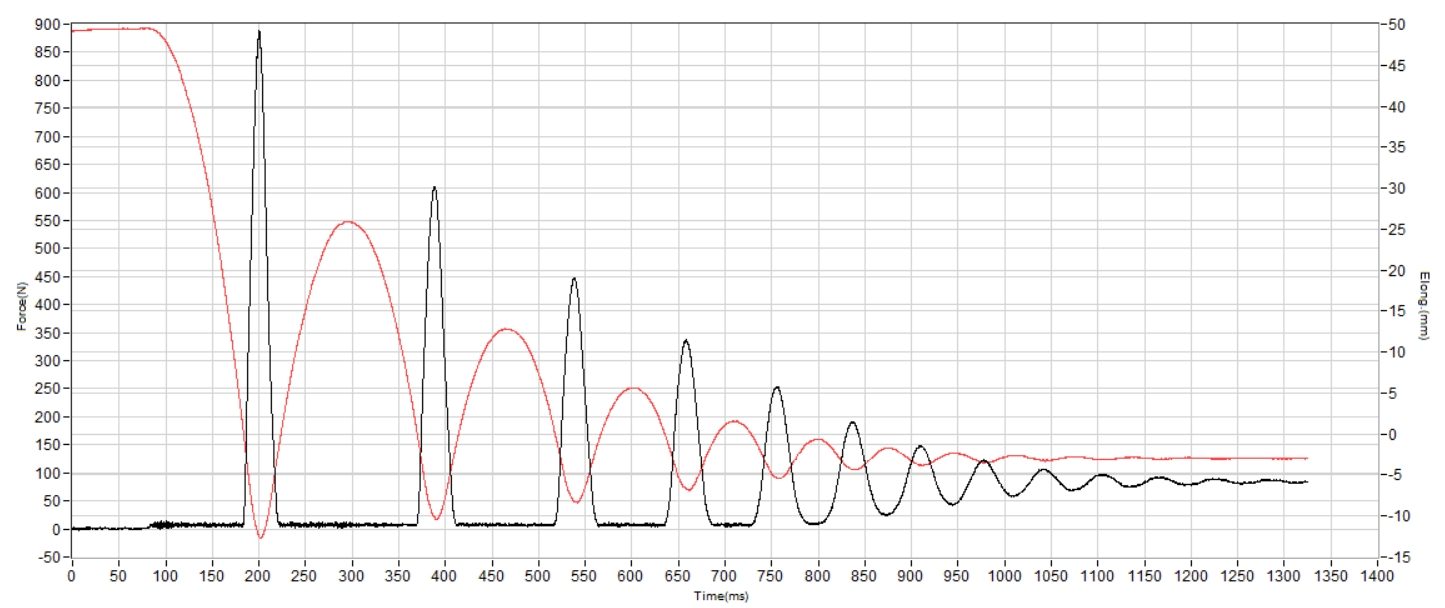
| Hyperion Elite 4 | 137 SA |
| Average | 129 SA |
Energy return
With just 56.2% energy return, this shoe is nowhere near supershoe territory. To earn that label in our lab, it needs to hit at least 70%—ideally closer to 75% or even 80%. That’s clearly not the case here.
| Hyperion Elite 4 | 56.2% |
| Average | 58.5% |
Heel stack
The midsole is always a key focus in any supershoe as it's where the performance enhancements really shine.
Our first observation concerns the heel stack, which we measured at an impressive 39.1 mm in the lab, nearly reaching the 40-mm limit set by World Athletics. This is excellent news for heel strikers who are preparing for the marathon.

| Hyperion Elite 4 | 39.1 mm |
| Average | 34.8 mm |
Forefoot stack
Contrary to expectations, we measured the forefoot at just 27.3 mm, which was unexpectedly low given the official 8 mm drop.
This measurement might make the shoe less suitable for forefoot strikers, who may find it doesn't align well with their running style.
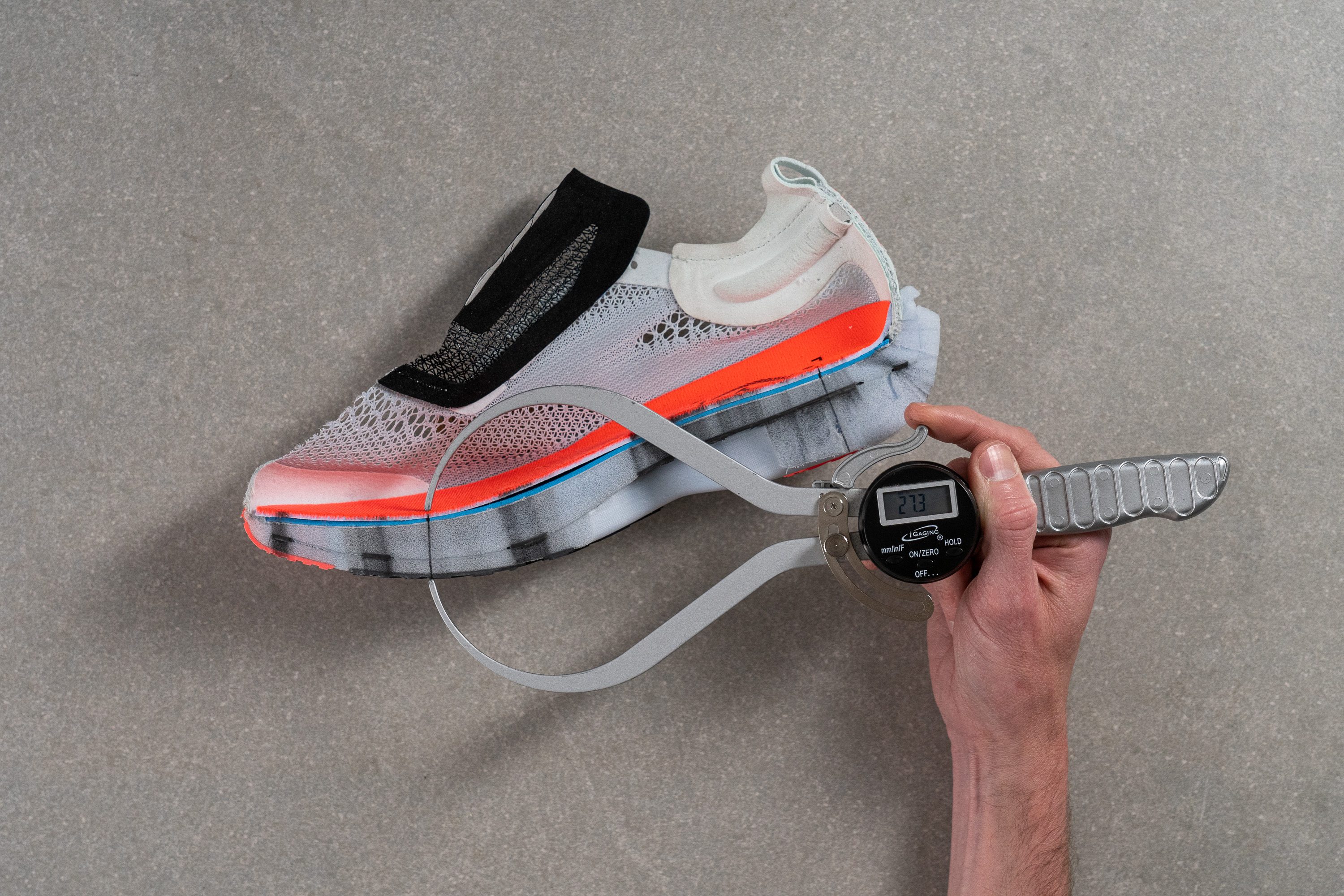
| Hyperion Elite 4 | 27.3 mm |
| Average | 26.2 mm |
Drop
We recorded an 11.8-mm heel-to-toe drop, quite substantial and ideally suited for heel strikers or those experiencing Achilles tendon or calf issues, as a significant drop can help alleviate stress in these areas.
Oh, you may be wondering why there are sometimes differences between our measurements and the brand's offsets, but don't worry—we have a guide that fully explains it.
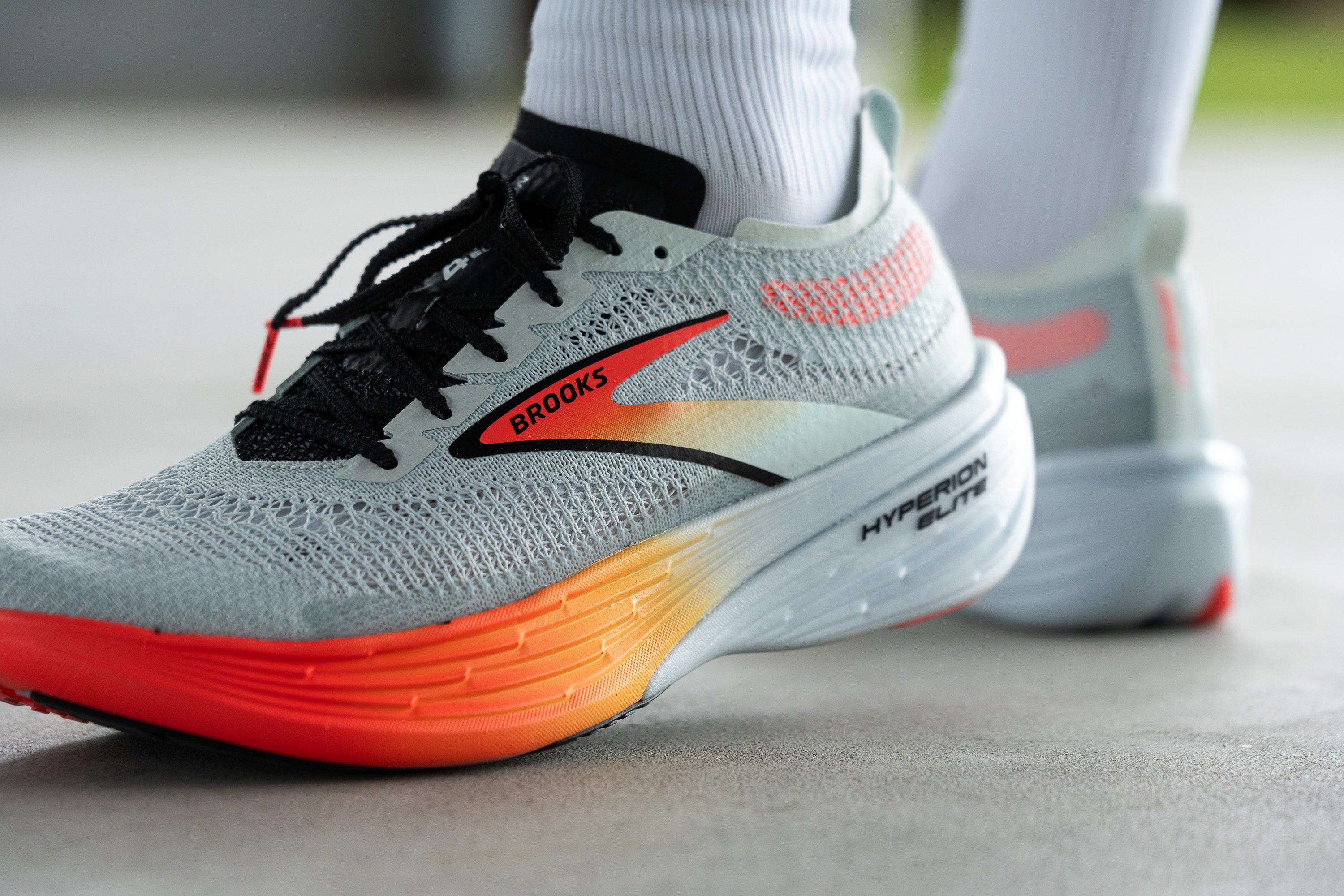
| Hyperion Elite 4 | 11.8 mm |
| Average | 8.6 mm |
Midsole softness
Turning our attention to the midsole, there's a significant discussion point—it represents the most disappointing aspect of the Hyperion Elite 4 and ultimately hinders our recommendation for those pursuing top-tier performance.
We found that Brooks opted for DNA Flash v2 foam, which doesn't measure up to the leading foams on the market like ZoomX or FF Turbo+. This shortfall is due to its composition as a supercritical, EVA-based foam rather than a PEBA-based material.

Despite Brooks' efforts to enhance it (less weight, more energy return) by infusing nitrogen, we discovered that it lacks the performance characteristics found in world-class foams. In essence, the midsole is adequate for training but falls short for serious racing by current standards.
Moreover, the price remains steep at £250, equivalent to other elite racing shoes. This makes the Hyperion Elite 4 suitable only for those willing to sacrifice some responsiveness. And we think that it’s unfortunate, especially for elite athletes like the Des Linden, a former Boston Marathon champ that deserve a fair competition with the rest of the field.
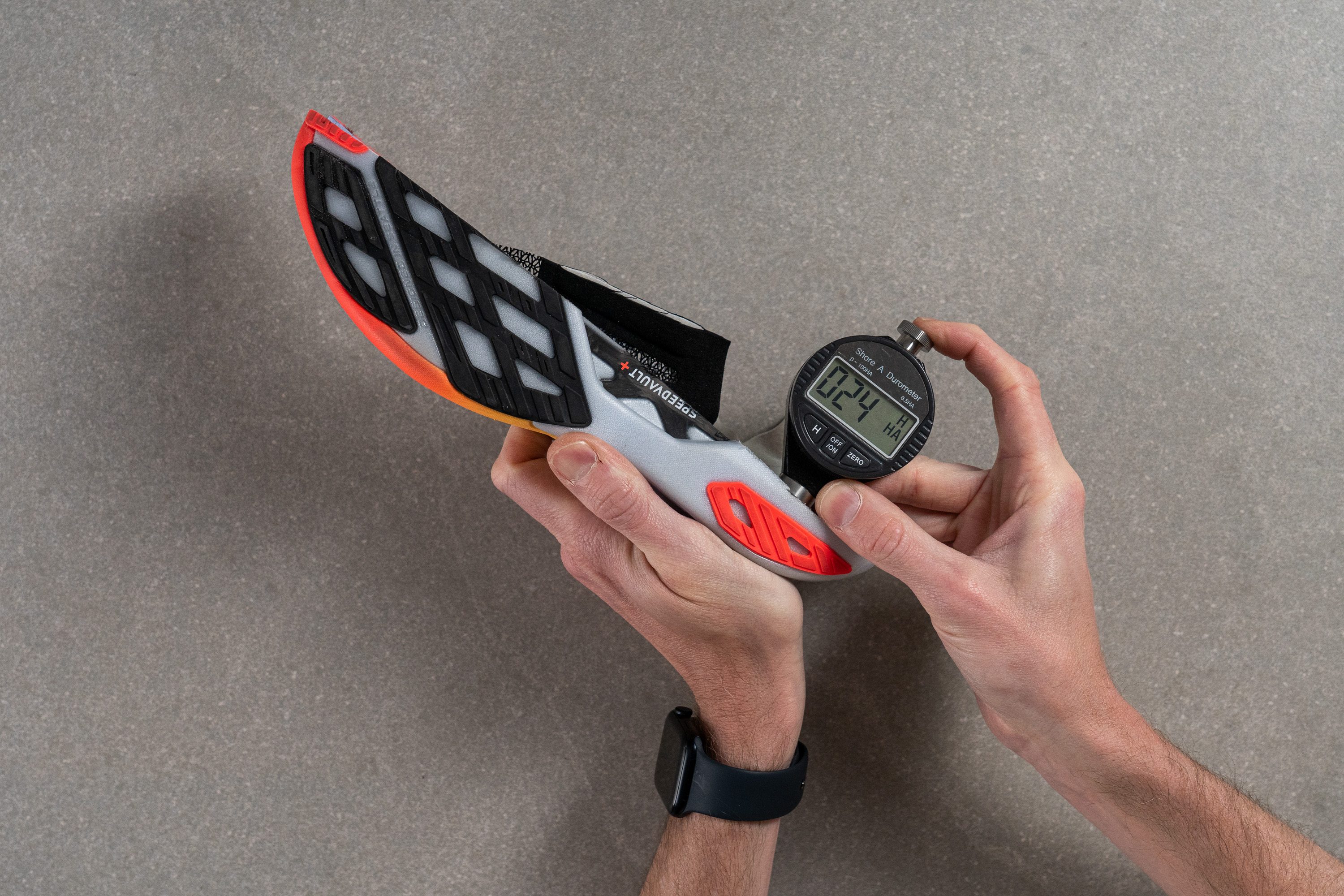
| Hyperion Elite 4 | 23.9 HA |
| Average | 20.4 HA |
Rocker
We discovered that the early-stage rocker of the Hyperion Elite 4 isn't as pronounced as in shoes like the Hoka Cielo X1, but it definitely provides a rockered ride, which is clear when observing its forefoot profile.
Conversely, the heel doesn't showcase a large bevel but features a modest one that starts quite far back, offering some guidance for rearfoot strikers without being intrusive. Overall, this shoe presents one of the most traditional racing dynamics in a contemporary racing shoe, a quality that many runners might find appealing.
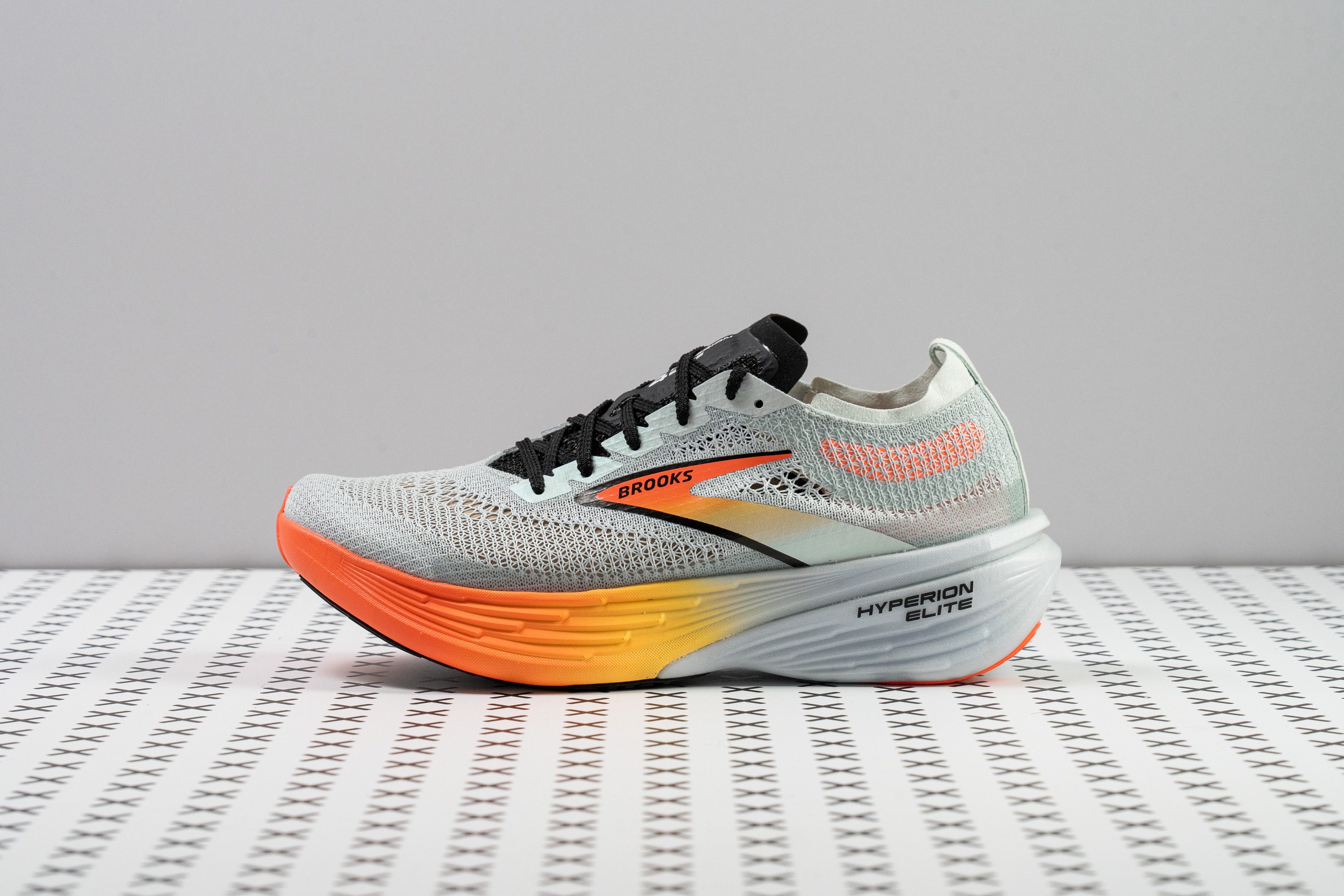
Plate
While Brooks may be somewhat behind with its EVA-based foam, they've truly did a great job with the innovative carbon plate in the Hyperion Elite 4.
The Speedvault+ carbon plate, crafted in partnership with ARRIS Composites in Berkeley, stands out from the typical carbon plates. We found that it's uniquely designed with several cutouts in the carbon fibre, maintaining rigidity while also reducing weight, which is evident through the midsole cutout.
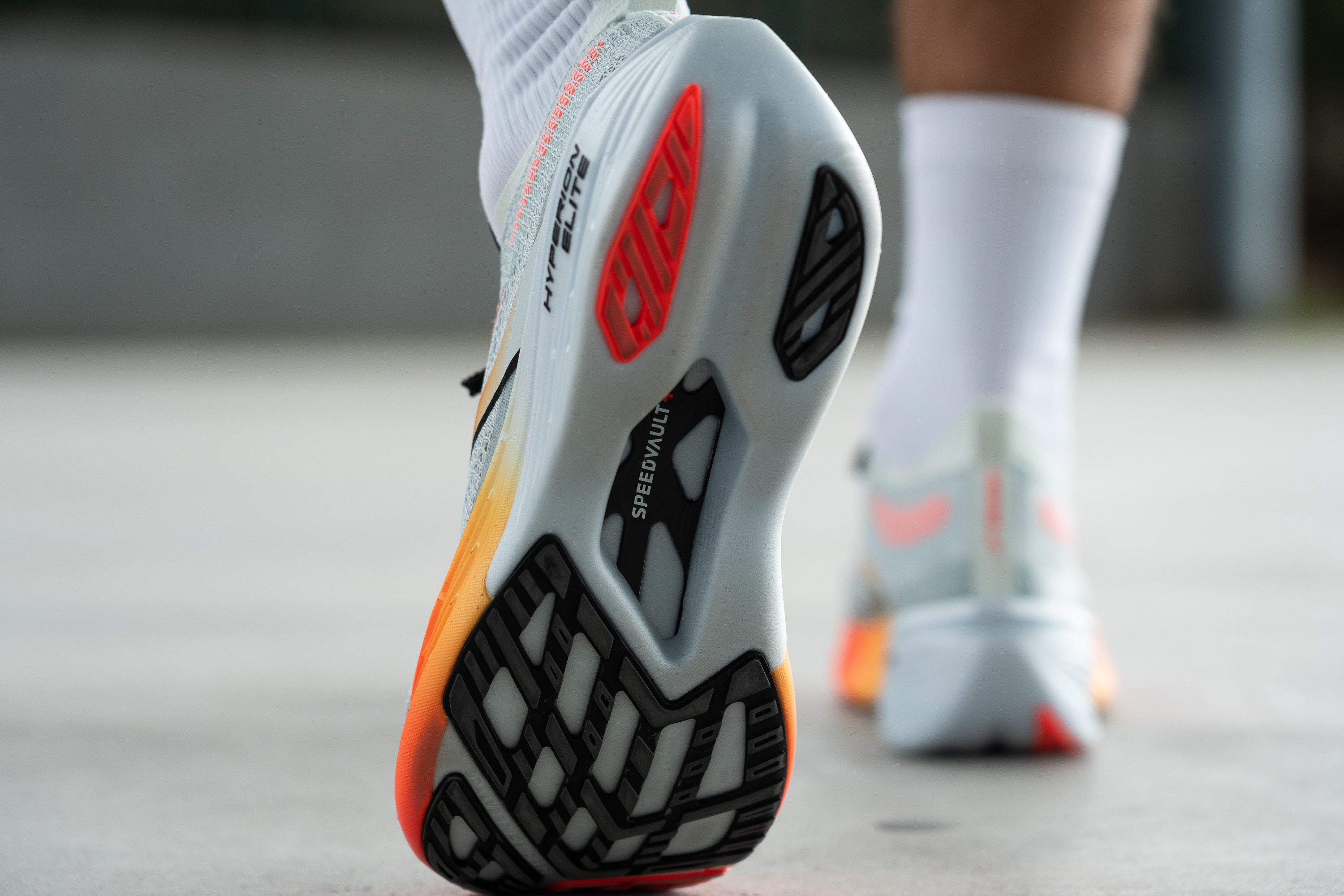
Another remarkable feature of this spoon-shaped carbon plate is that its stiffness varies with each shoe size—a departure from the usual practice where other supershoes use the same plate stiffness across different sizes. It’s great to see Brooks pushing the envelope!

Size and fit
Size
Brooks Hyperion Elite 4 fits true to size (22 votes).
Width / Fit
We always take multiple width measurements to ensure precision, which is particularly crucial in racing shoes that tend to be narrower than daily trainers.
Our shoe-width lab measurement for the Hyperion Elite 4 came in at 92.6 mm—undeniably narrow when compared to average shoes. According to our experience, this wasn’t surprising, as the midfoot fit is also exceptionally snug.
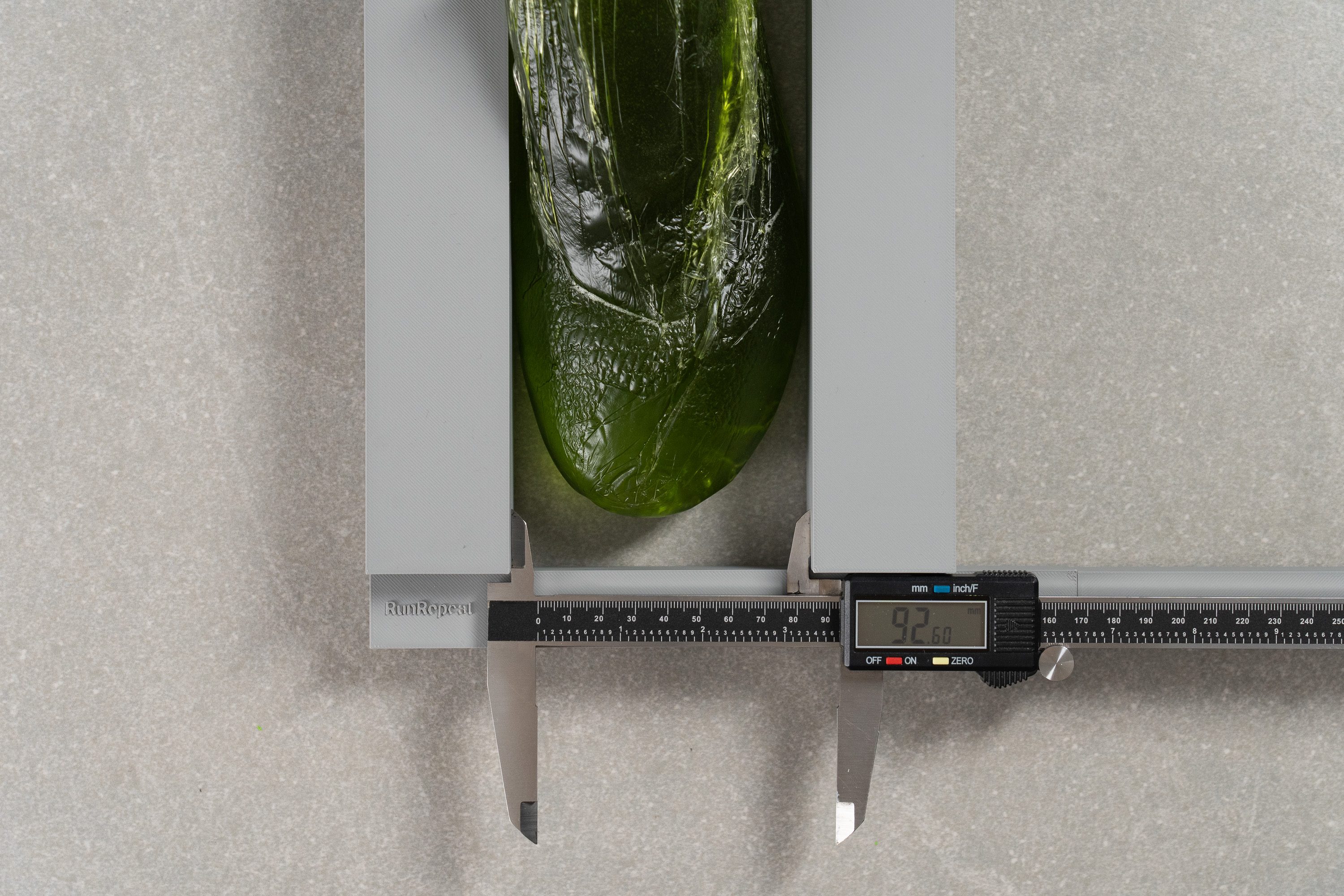
| Hyperion Elite 4 | 92.6 mm |
| Average | 95.1 mm |
Toebox width
The Hyperion Elite 4 features a moderately tapered toebox measuring 73.6 mm.
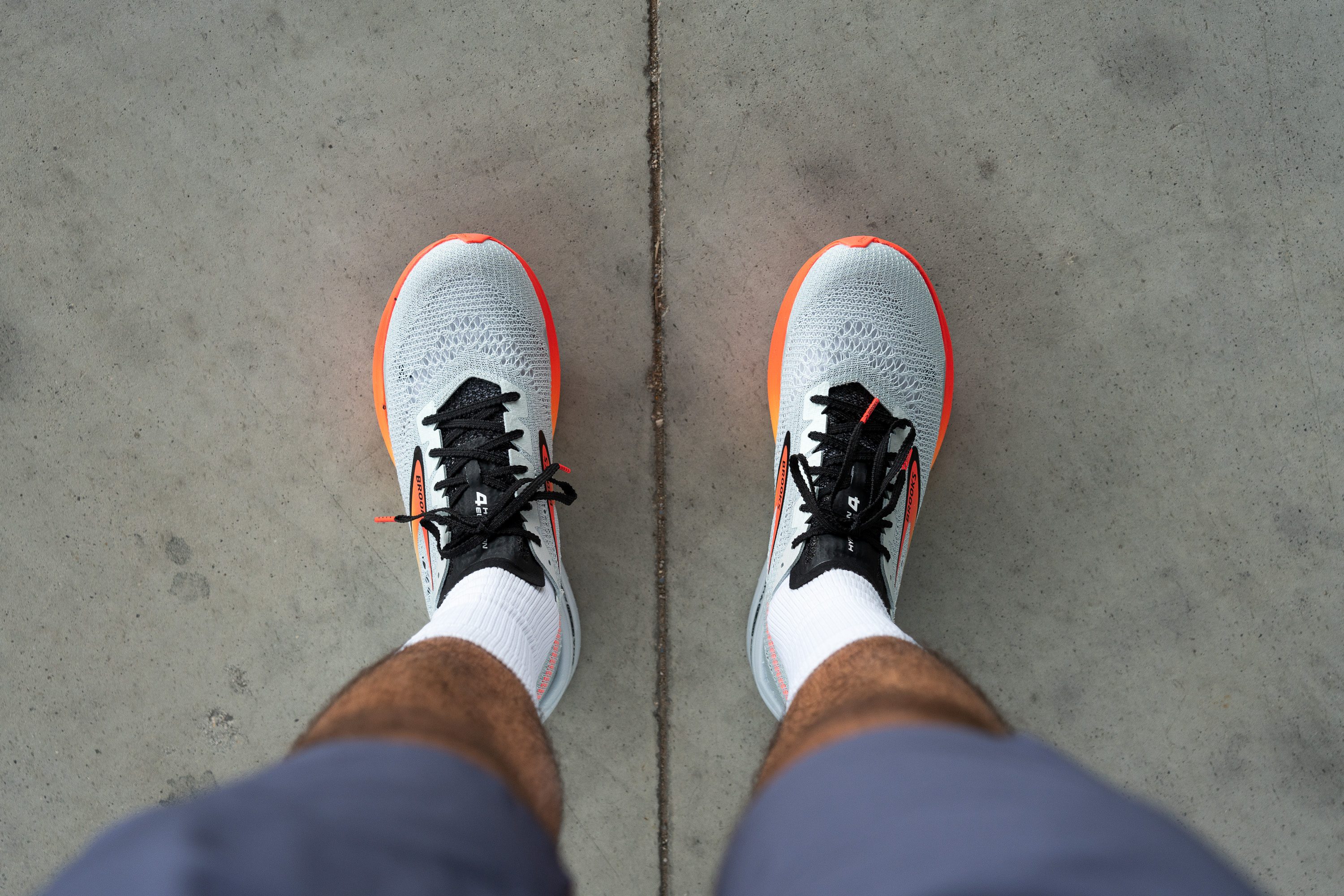
According to this finding, while the midfoot offers a secure fit, the front opens up just enough to provide reasonable space for most runners.
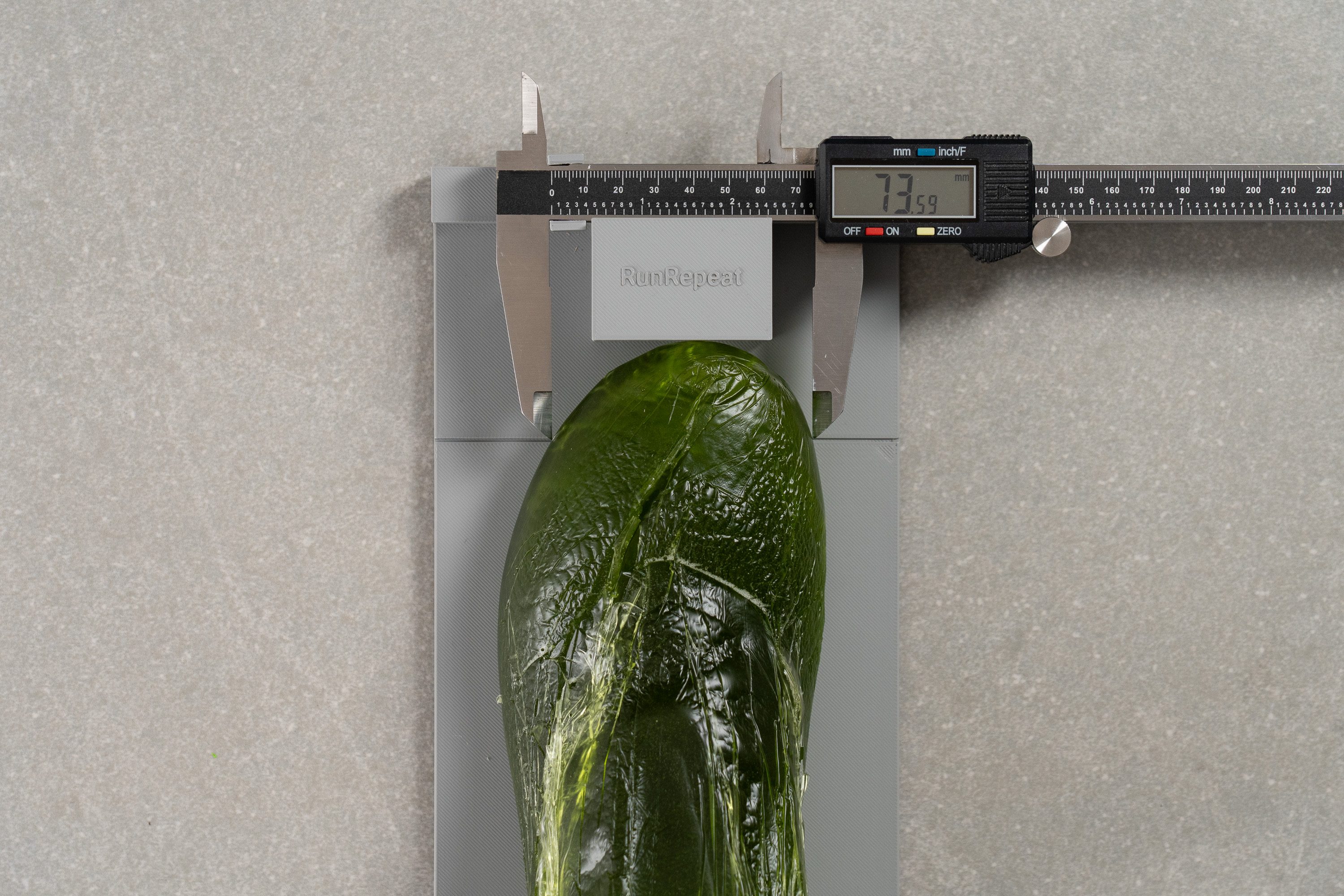
| Hyperion Elite 4 | 73.6 mm |
| Average | 73.2 mm |
Toebox height
Those with high-volume feet or who often experience toe pressure in most shoes should definitely consider the Elite 4 as their racing option. Measuring 28.1 mm, it offers more vertical room than most racing shoes!
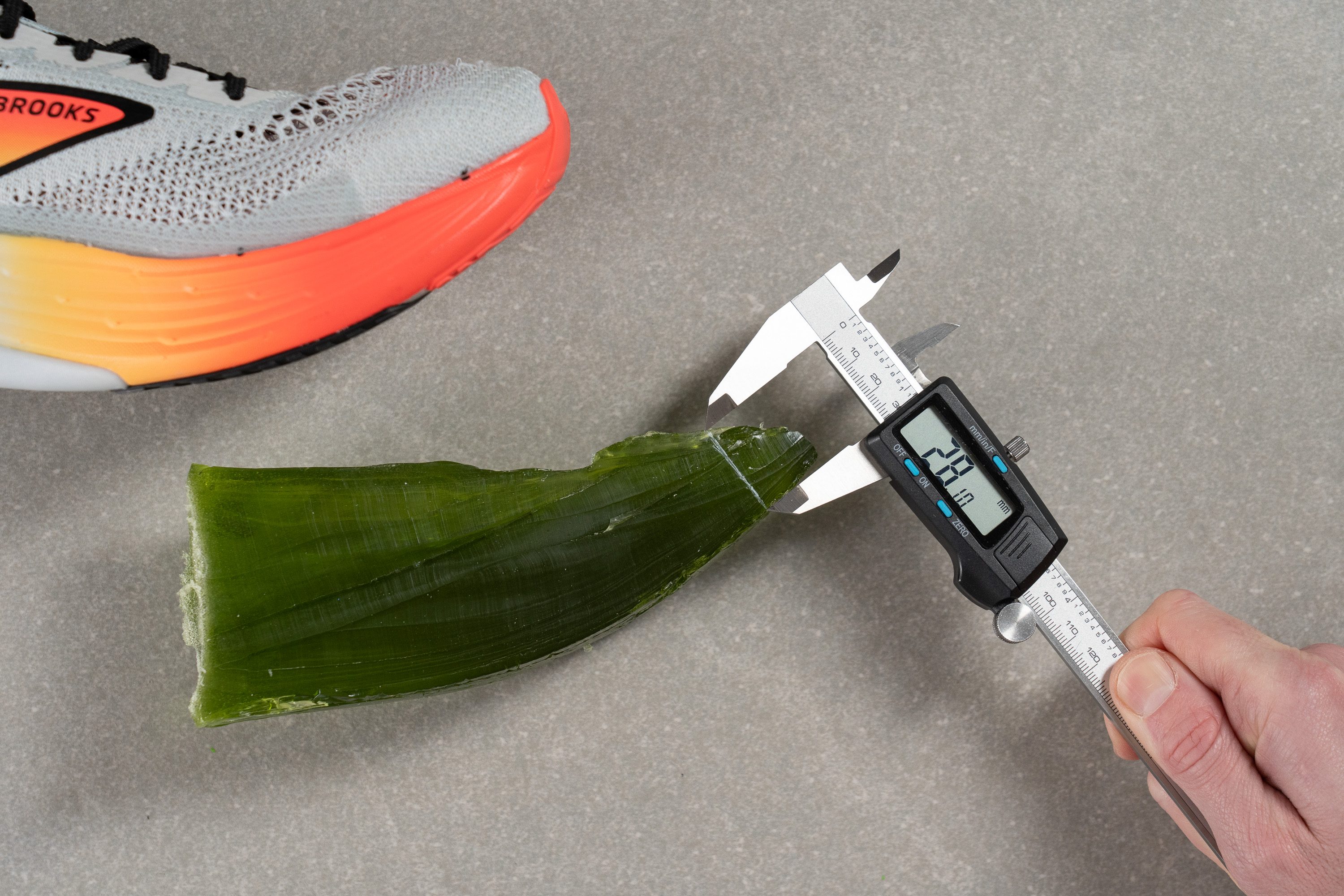
| Hyperion Elite 4 | 28.1 mm |
| Average | 27.1 mm |
Traction / Grip
Traction test
Rain or shine, the Hyperion Elite 4's grippy outsole has got your back.
Testing the shoe's forefoot grip with a SATRA TM144 method confirmed that this race shoe has just enough bite even for wet concrete. Its coefficient of friction comes in at 0.50 which is not as tacky as in the ASICS Metaspeed shoes but still grippy enough to prevent unwanted slips.
| Hyperion Elite 4 | 0.50 |
| Average | 0.48 |
Outsole design
The outsole boasts decent rubber coverage in the forefoot and strategically-placed rubber in the heel, plus a massive central groove that reveals the Speedvault+ carbon plate.
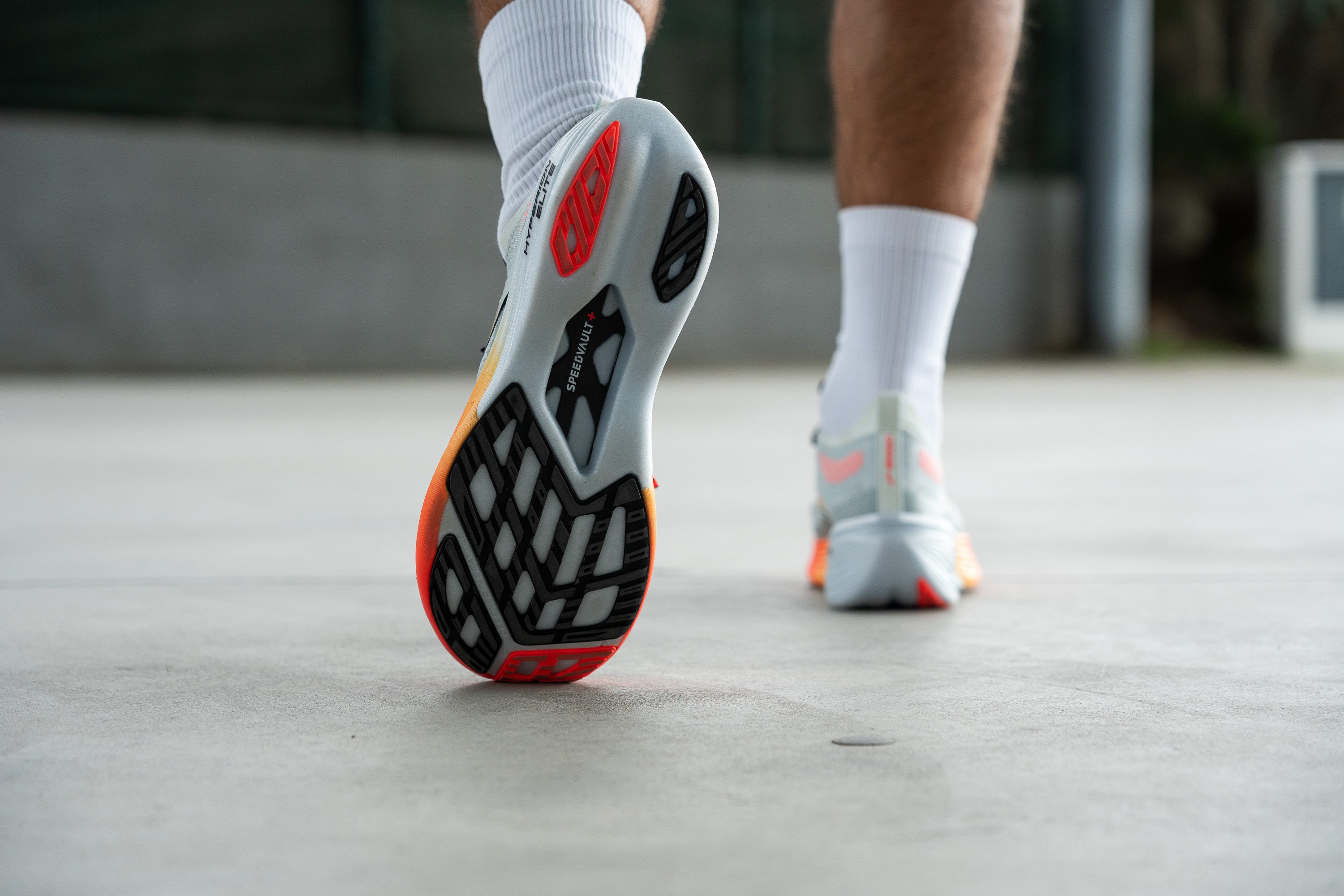
Flexibility / Stiffness
Using our custom machine, we had to apply a significant 26.8N to bend the shoe to a 30-degree angle. That’s definitely stiff—but with a carbon plate nestled between two layers of DNA Flash v2 foam, the Hyperion Elite 4 was built for this.
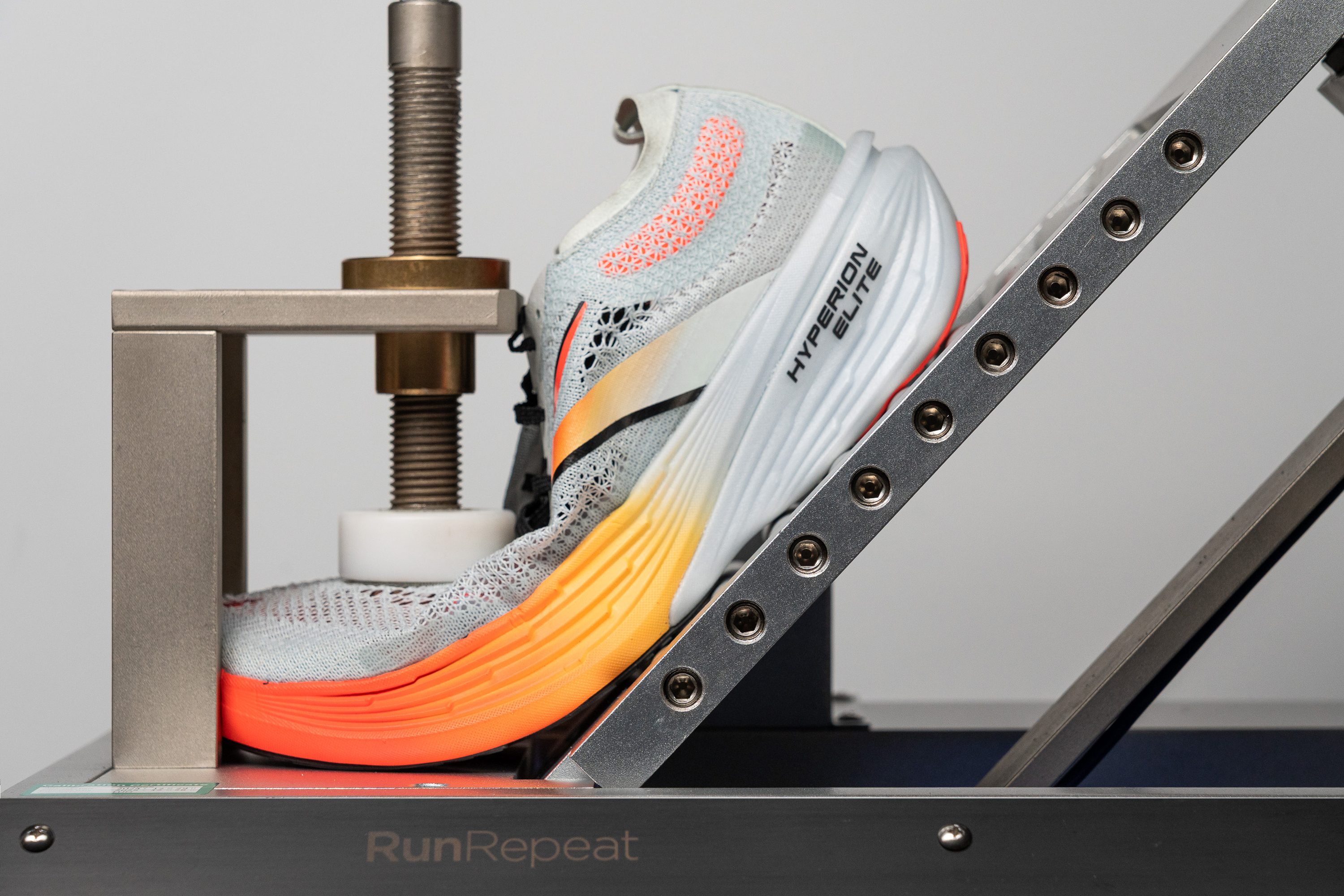
| Hyperion Elite 4 | 26.8N |
| Average | 15.3N |
Stiffness in cold (%)
To assess how the stiffness would be affected by cold, we put it in the freezer for 20 minutes before testing again with the force gauge. Afterwards, we noted a modest 6.8% increase in stiffness—a good result that likely stems from the presence of the carbon plate in between the foam.
| Hyperion Elite 4 | 7% |
| Average | 33% |
Weight
Here's our first major issue with the Brooks Hyperion Elite 4.
Weighing in at 7.8 oz or 220g, it's noticeably heavier than expected for a supershoe. For comparison, it's 0.7 oz heavier than the Nike Alphafly 3, which offers more a broader midsole and more cushioning underfoot.
Where does this extra weight originate? The Hyperion Elite 4 includes a state-of-the-art, razor-thin upper, so the real culprits are the midsole and the outsole. We strongly believe that to truly compete in the supershoe arena, Brooks needs to adopt a thinner rubber and a lighter, next-generation midsole in order to put the next version below 7 ounces.

| Hyperion Elite 4 | 7.8 oz (220g) |
| Average | 9.3 oz (264g) |
Breathability
As soon as we unboxed the Hyperion Elite 4, we were instantly captivated by its knit upper. Apart from the Nike Vaporfly 3 with its Flyknit fancy tech, it's challenging to recall any other shoe with such meticulously crafted and high-quality ventilation.
During our smoke-pumping test, it became clear that this shoe was destined for a top score of 5/5. It boasts large, exceptional ventilation holes that allow air to flow seamlessly. In fact, we suggest wearing thick socks in cooler temperatures due to the extensive airflow.
After the smoke test, we shone a light through the upper to inspect it further, and wow—never before have we observed such incredible full-length ventilation. It goes from the heel to the toe, ensuring that overheating won't be an issue, even during the late miles of a summer marathon.
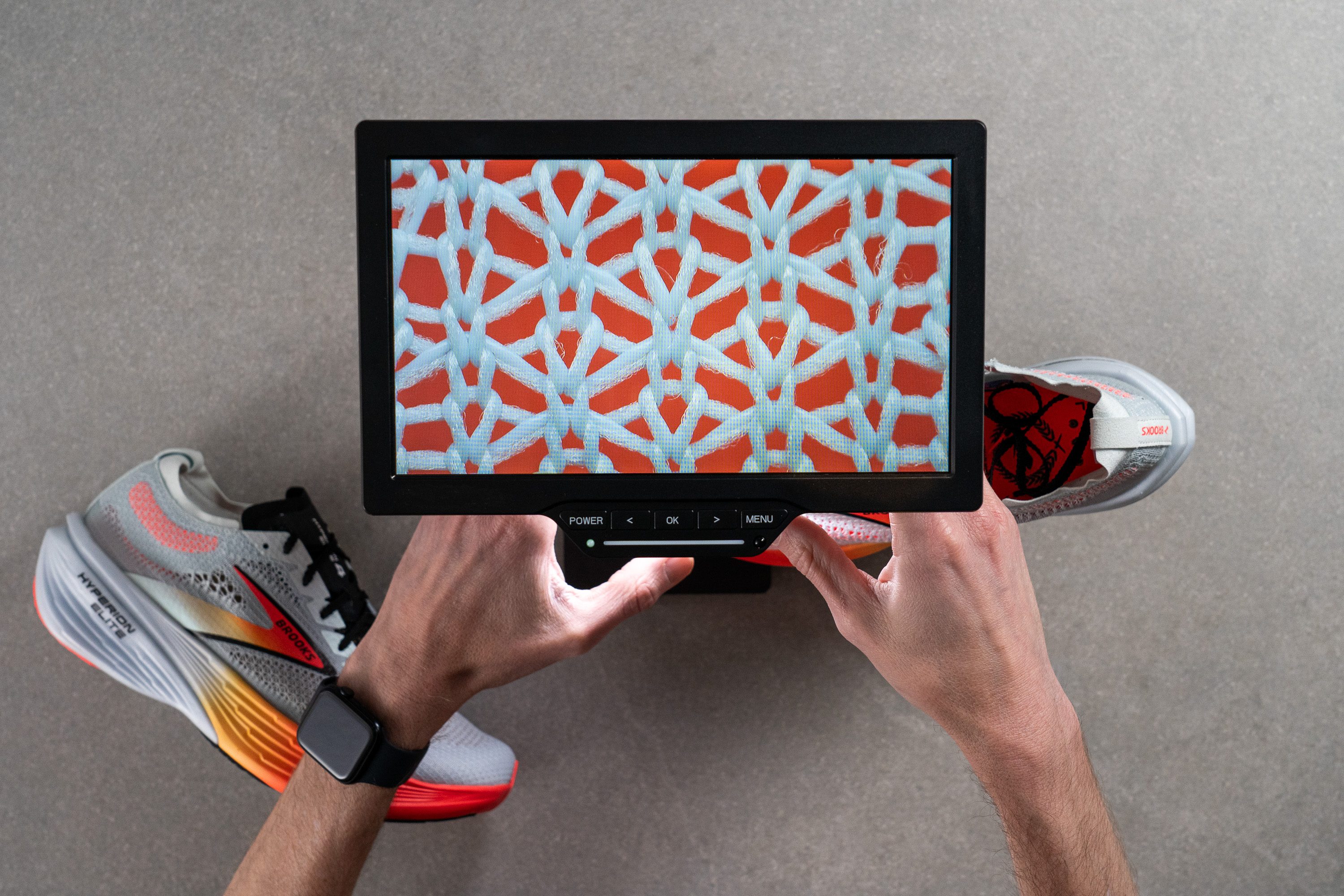
We then took a deeper look at the upper using a microscope and what we saw was truly stunning.
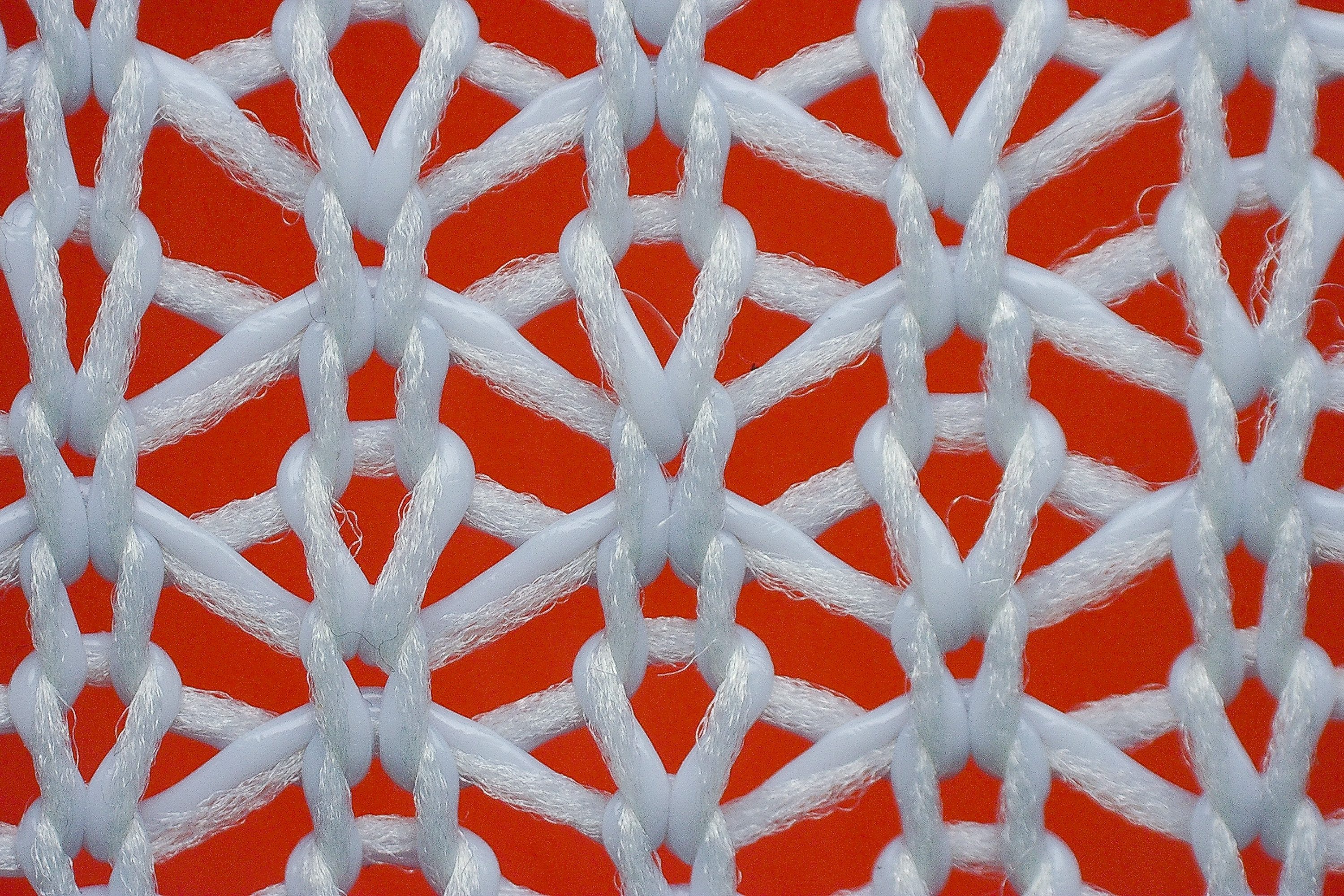
However, our focus wasn't on the largest holes but on those in the centre of the toebox, which were equally impressive.
In our final manual assessment of the upper, we noted that, as expected in a race day shoe, it isn't very padded. Additionally, the knit is quite stretchy, which might raise some concerns about durability.
| Hyperion Elite 4 | 5 |
| Average | 3.7 |
Stability
Lateral stability test
Having evaluated the midsole, we now shift our focus to the stability features of the Hyperion Elite 4. Surprisingly, we found that despite its tall and narrow profile, it ranks as one of the most stable racing shoes available.
Interestingly, this stability advantage comes from an unexpected source—the DNA Flash v2 foam. While typically less favoured than PEBA-based foams for responsiveness, it actually contributes to making this shoe more supportive than many of its competitors. This scenario is a perfect example of how a perceived shortcoming can at least enhance performance in another area.
Torsional rigidity
With a carbon-fibre plate, we expected this test to score at least a 4 out of 5, but it actually reached a 5. We attempted to bend and twist it, but it was incredibly rigid...
| Hyperion Elite 4 | 5 |
| Average | 3.5 |
Heel counter stiffness
The heel counter is composed of a thin pliable piece of cardboard, so it was no surprise to us that it offered virtually no resistance. Naturally, this led to a low rating of 1 out of 5 on our scale.
| Hyperion Elite 4 | 1 |
| Average | 2.9 |
Midsole width - forefoot
We've noted previously in this lab review that the Hyperion Elite 4 feels quite narrow, and now we have the measurements to support that observation.
Our initial measurement focused on the forefoot area, where we recorded a width of 110.3 mm. This indeed confirms the feelings we had during our runs.
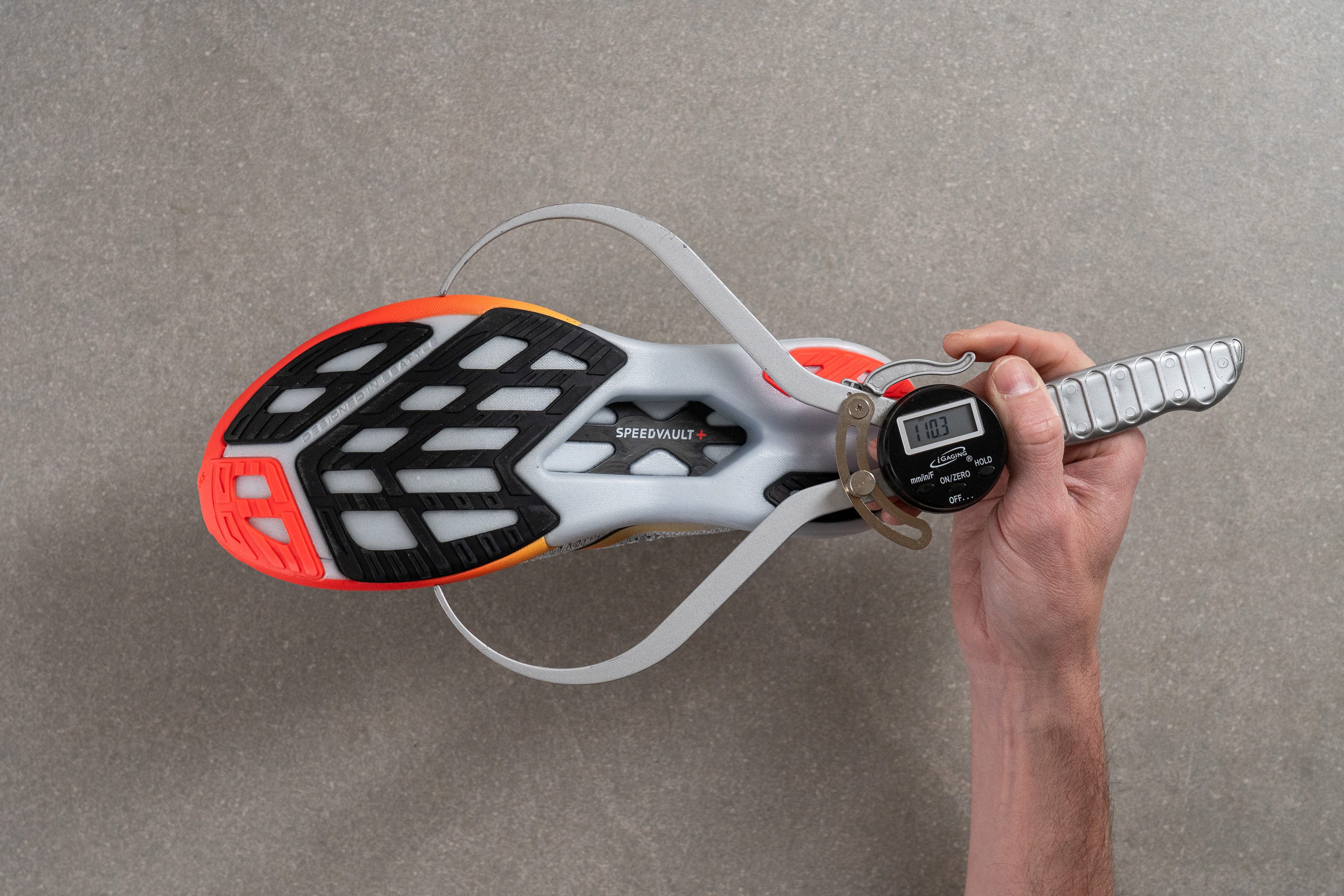
| Hyperion Elite 4 | 110.3 mm |
| Average | 114.4 mm |
Midsole width - heel
Although the Hyperion Elite 4 is somewhat more stable than other supershoes, its heel is notably narrow at just 78.5 mm. This could pose challenges for heel strikers, though runners with a neutral stride may not find it problematic. Ultimately, we must remember that this is primarily a racing shoe.
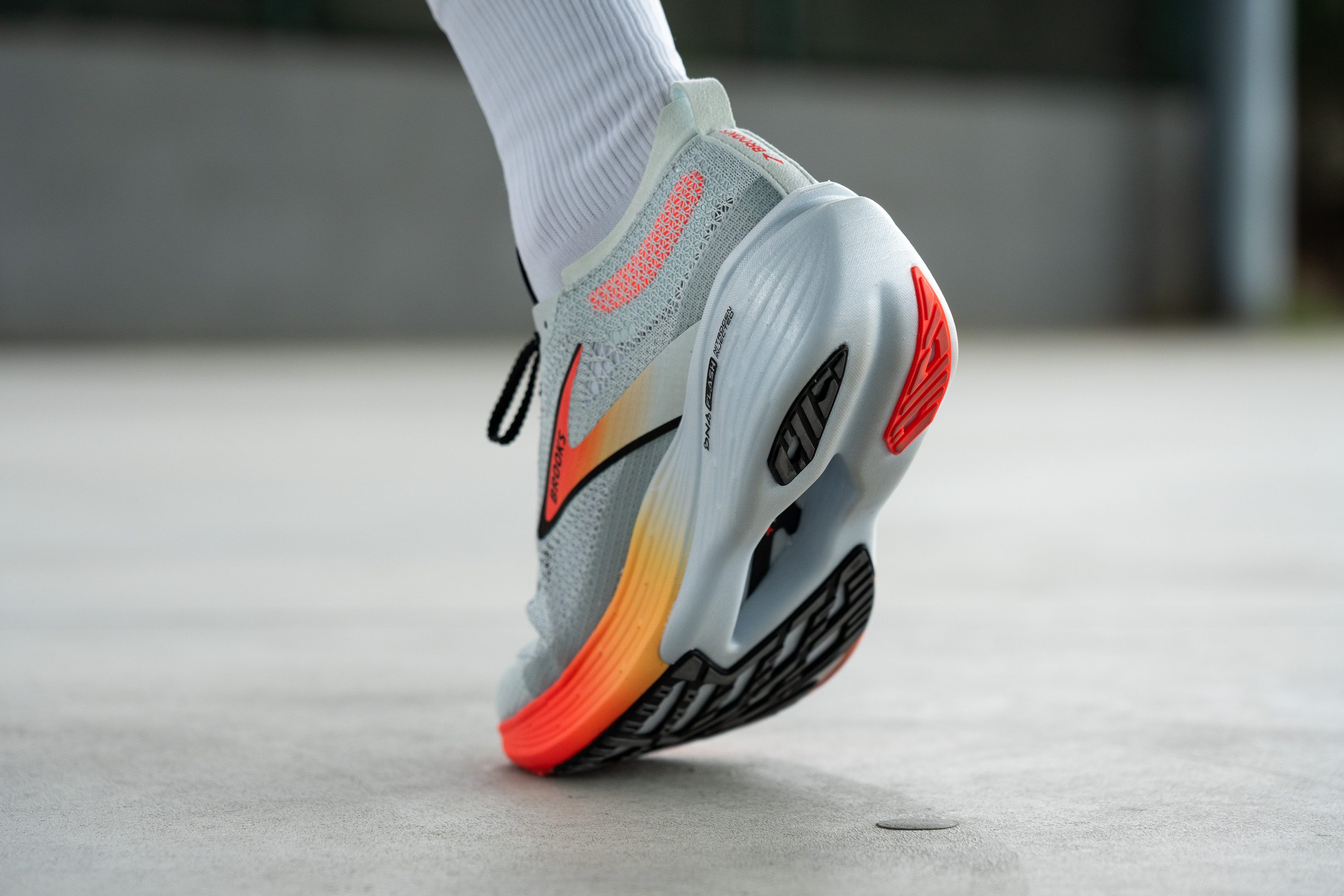
If heel width is a concern for you, consider alternatives like the New Balance FuelCell SuperComp Elite v4. Not only does it have an infinite name, but it also offers a broader heel width of 88.7 mm.

| Hyperion Elite 4 | 78.5 mm |
| Average | 90.7 mm |
Durability
Toebox durability
Turning now to durability—let's fire up the Dremel! In our initial test, we're eager to see how this paper-thin, minimally padded upper stands up to the tool.
We were pleasantly surprised. Although it scored just 2/5, we view this as a positive outcome for such a featherweight upper. In other words—while we assess all shoes by the same standards, we recognise the significant achievement of obtaining this score with an upper like this one.
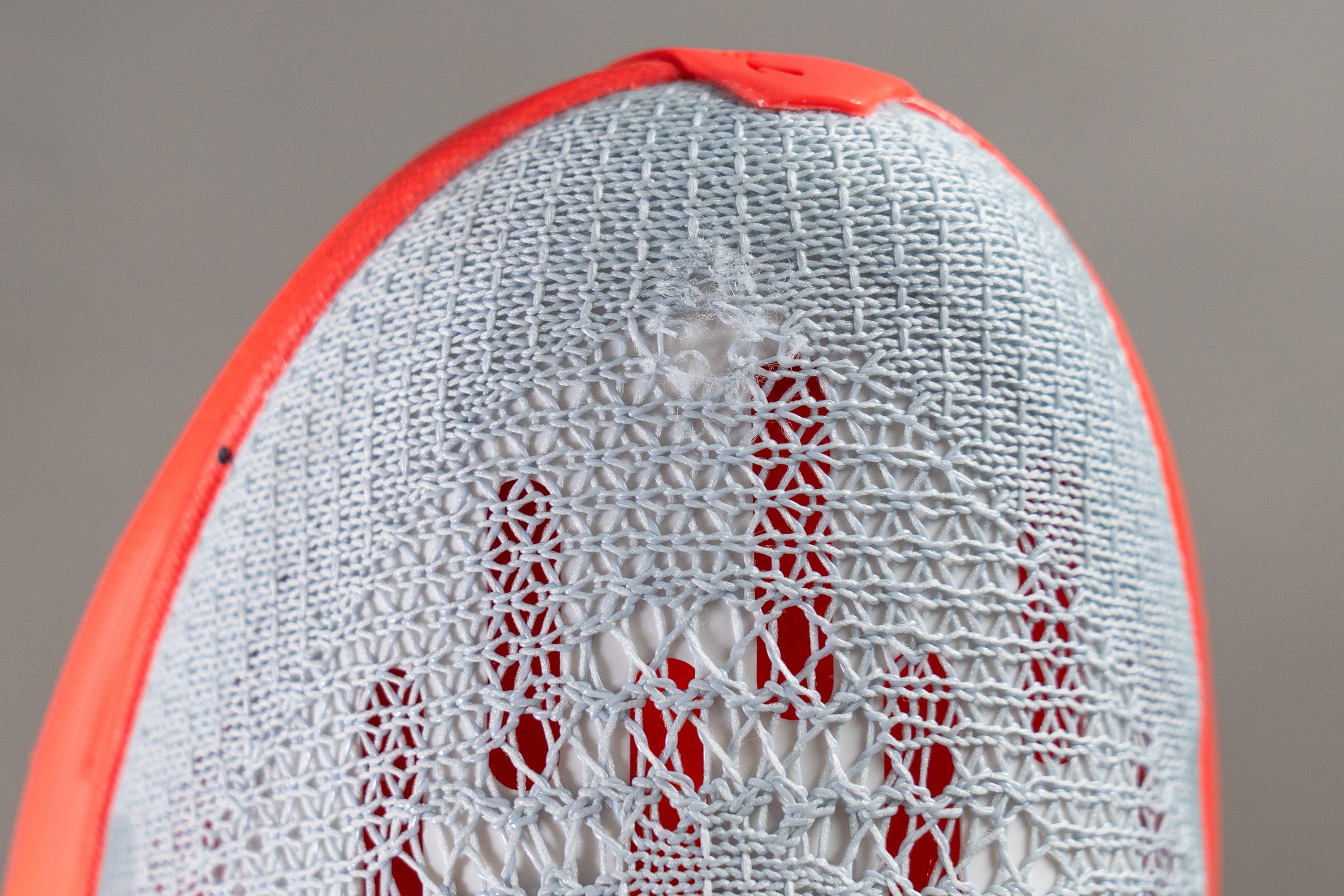
| Hyperion Elite 4 | 2 |
| Average | 2.6 |
Heel padding durability
After examining the exceptional upper, we shifted our focus to the heel padding, hopeful for a high score.
The outcome was extraordinary—the minimal padding Brooks incorporated in the heel area demonstrated remarkable durability (5/5). It was truly a fantastic performance.
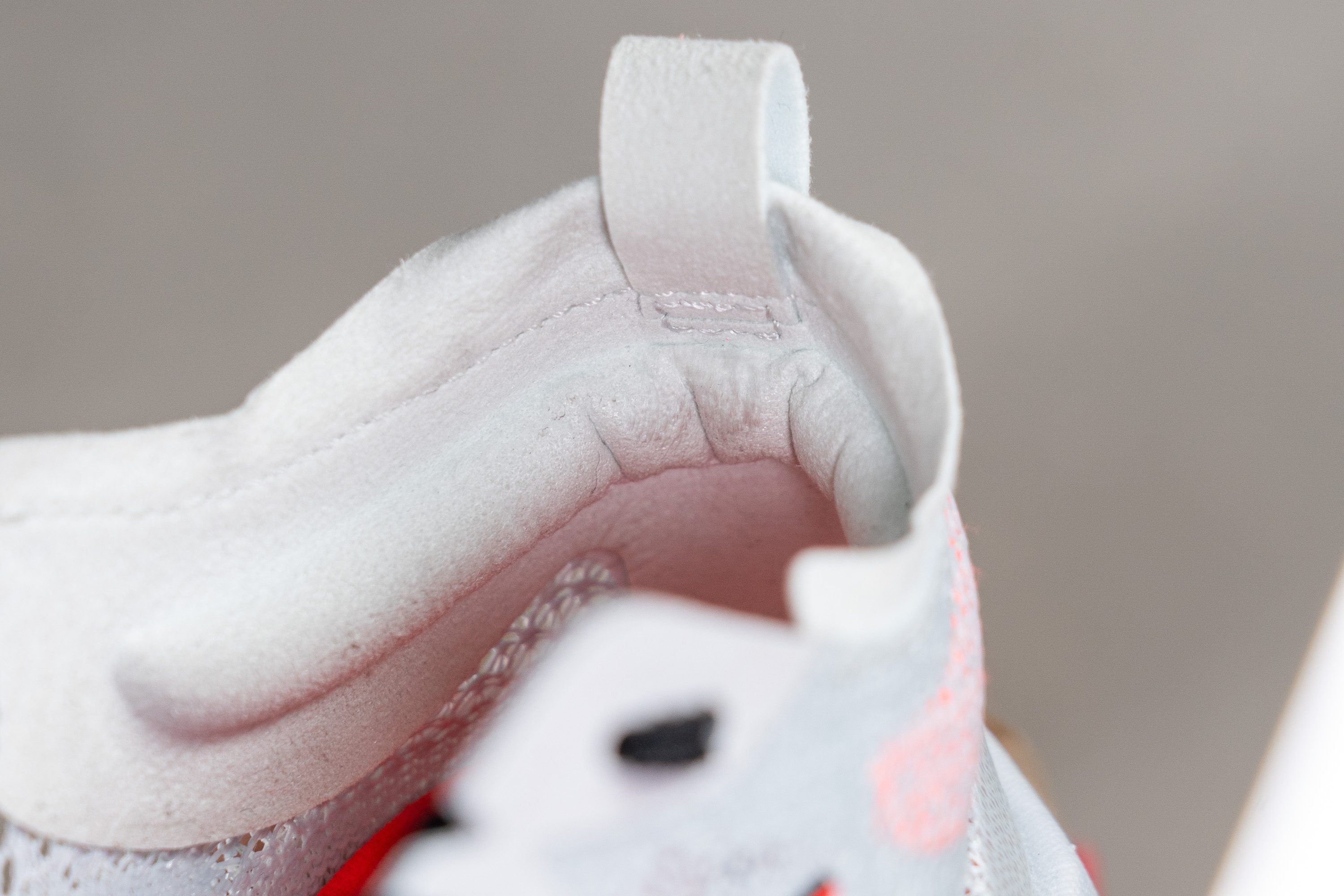
| Hyperion Elite 4 | 5 |
| Average | 3.4 |
Outsole hardness
Now it's time to evaluate the outsole. While the traction was satisfactory—it wasn't as impressive as PumaGrip (PUMA Deviate Nitro Elite 2) or Continental (Adidas Adizero Adios Pro 3).

First, we tested the rubber's hardness with a durometer in our lab. It registered at 79.4 HC, positioning it on the harder end of the spectrum for a race-oriented outsole.
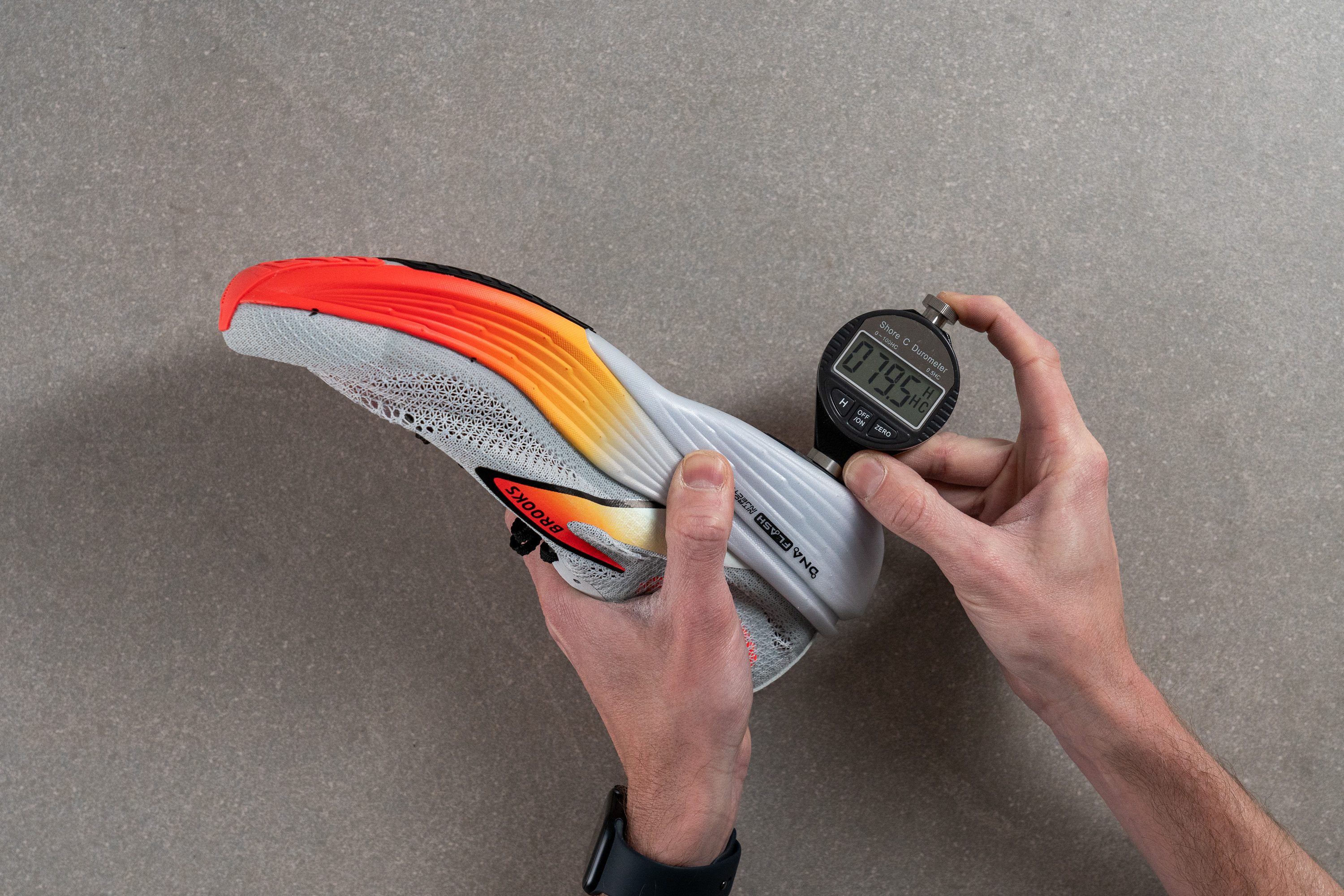
| Hyperion Elite 4 | 79.4 HC |
| Average | 79.2 HC |
Outsole durability
The previous measurement indicated promising durability for a racing shoe. To confirm this, we fired up the Dremel one last time until the next shoe comes into the lab.
After the Dremel finished its work, we observed a minimal 0.8 mm indentation—a remarkable result for a top-tier marathon shoe. Those worried about the durability of this rubber can rest easy!
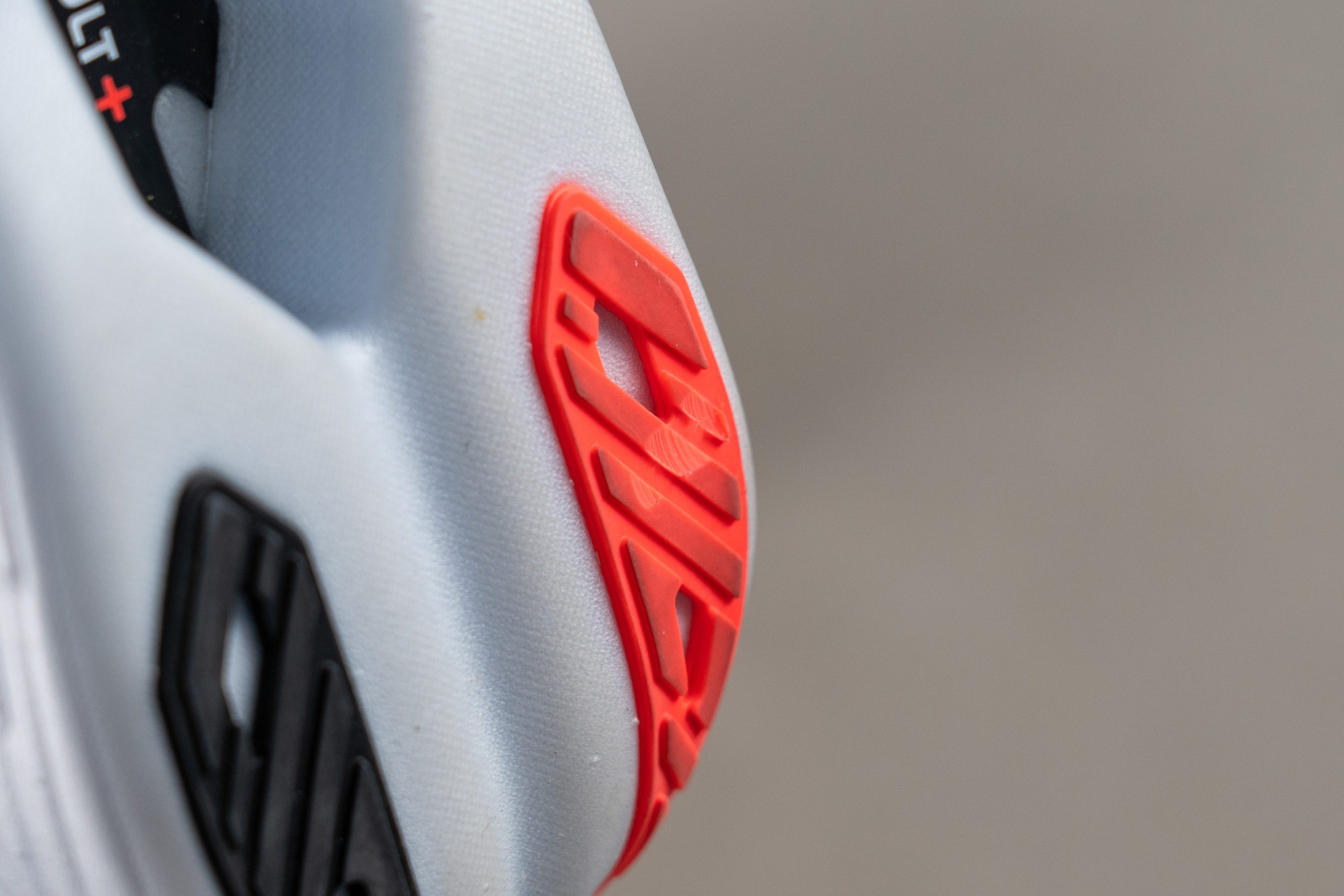
| Hyperion Elite 4 | 0.8 mm |
| Average | 1.1 mm |
Outsole thickness
We believe Brooks saw the outsole's durability as a unique opportunity to distinguish itself from other supershoes, so they included a 2.3 mm thickness to boost its longevity.
While it might appear thin at first glance, rest assured, it's quite generous for a marathon shoe.

| Hyperion Elite 4 | 2.3 mm |
| Average | 3.2 mm |
Misc
Insole thickness
The insole is exactly what we look for in a high-quality racing shoe—it's incredibly thin at just 3.0 mm.
Why is this beneficial? Well, because it enables the brand to maximise the use of performance-enhancing foam, crucial for boosting overall performance keeping the HE4 below the 40-mm legal limit imposed by World Athletics.

| Hyperion Elite 4 | 3.0 mm |
| Average | 4.5 mm |
Removable insole
This competition shoe allows you to swap out the insole, as we discovered it's not glued down.
However, it's essential to keep in mind that the interior space is quite snug as we proved before, so if you opt for a replacement, choose a razor-thin third-party footbed to ensure a proper fit.
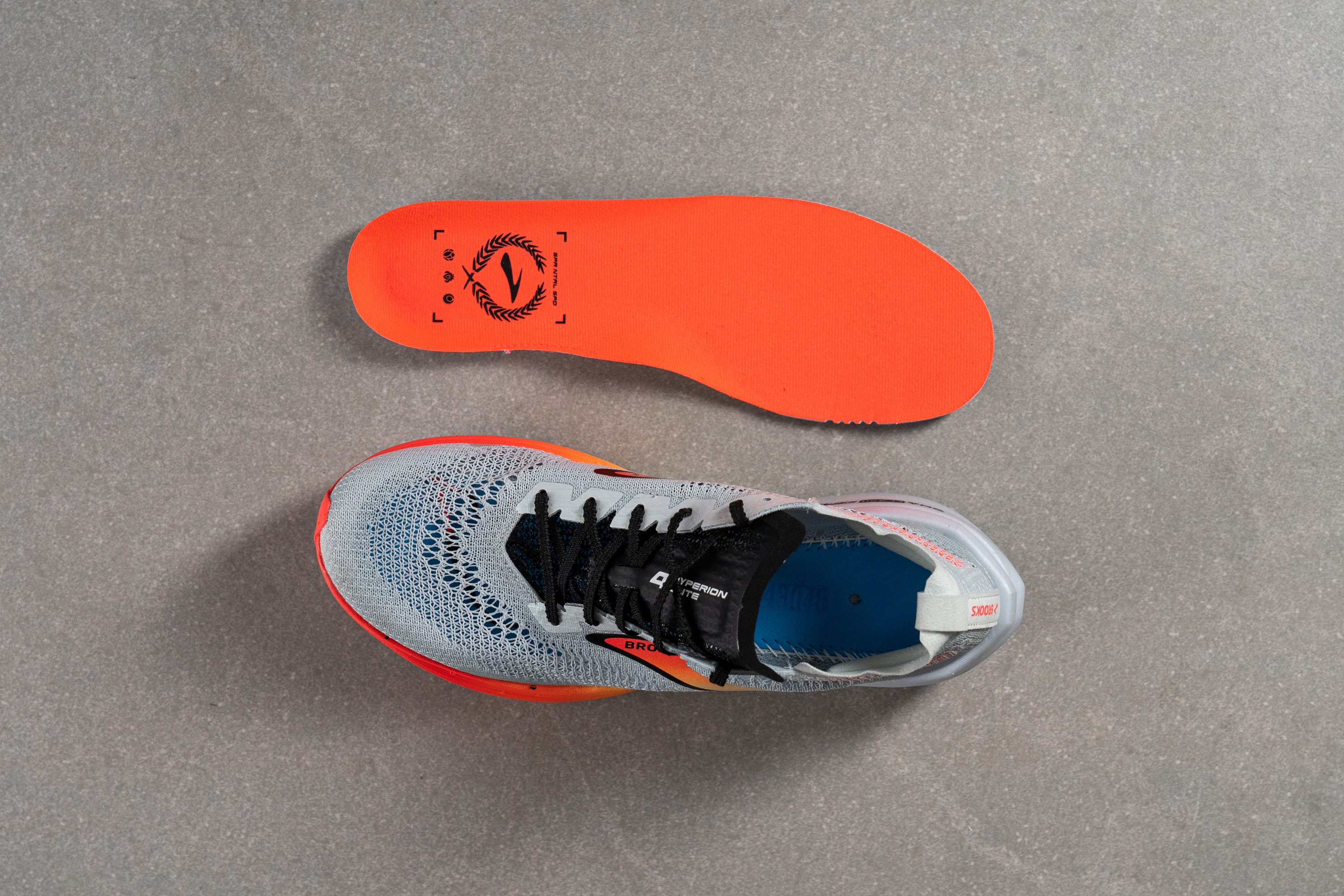
| Hyperion Elite 4 | Yes |
Midsole softness in cold (%)
To assess the Hyperion's adaptability to cold conditions, we conducted a test where it was frozen for 20 minutes before re-evaluating its performance. The results showed a 15.7% change—a solid performance for an EVA-based foam, which is generally less resilient in such temperature variations.

| Hyperion Elite 4 | 16% |
| Average | 24% |
Reflective elements
We found that the Brooks Hyperion Elite 4 does not include reflective elements.
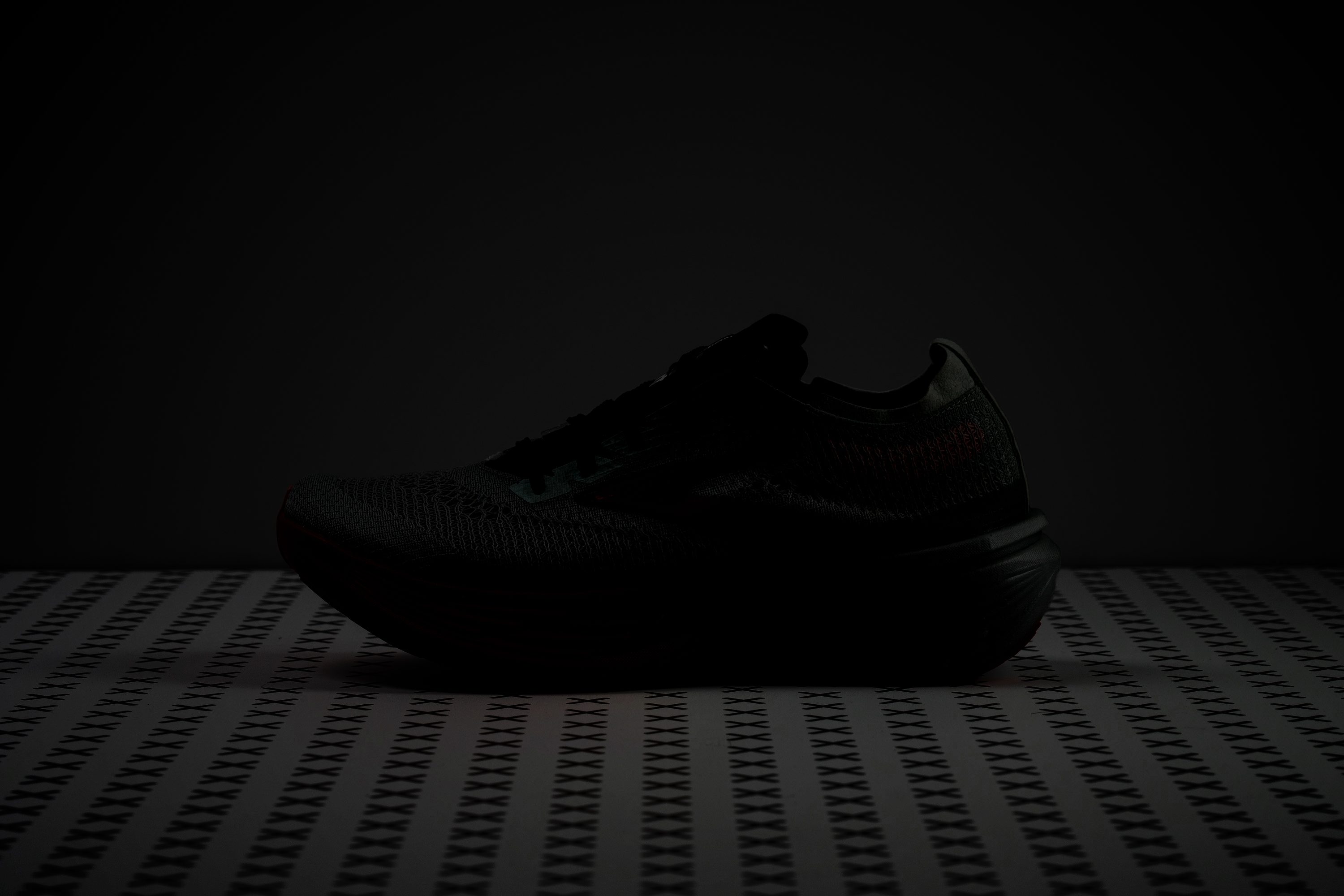
| Hyperion Elite 4 | No |
Tongue padding
The tongue of the Hyperion Elite 4 stands out from most racing shoes by offering a cushioned 5.5 mm padding; however, not throughout its entire length.
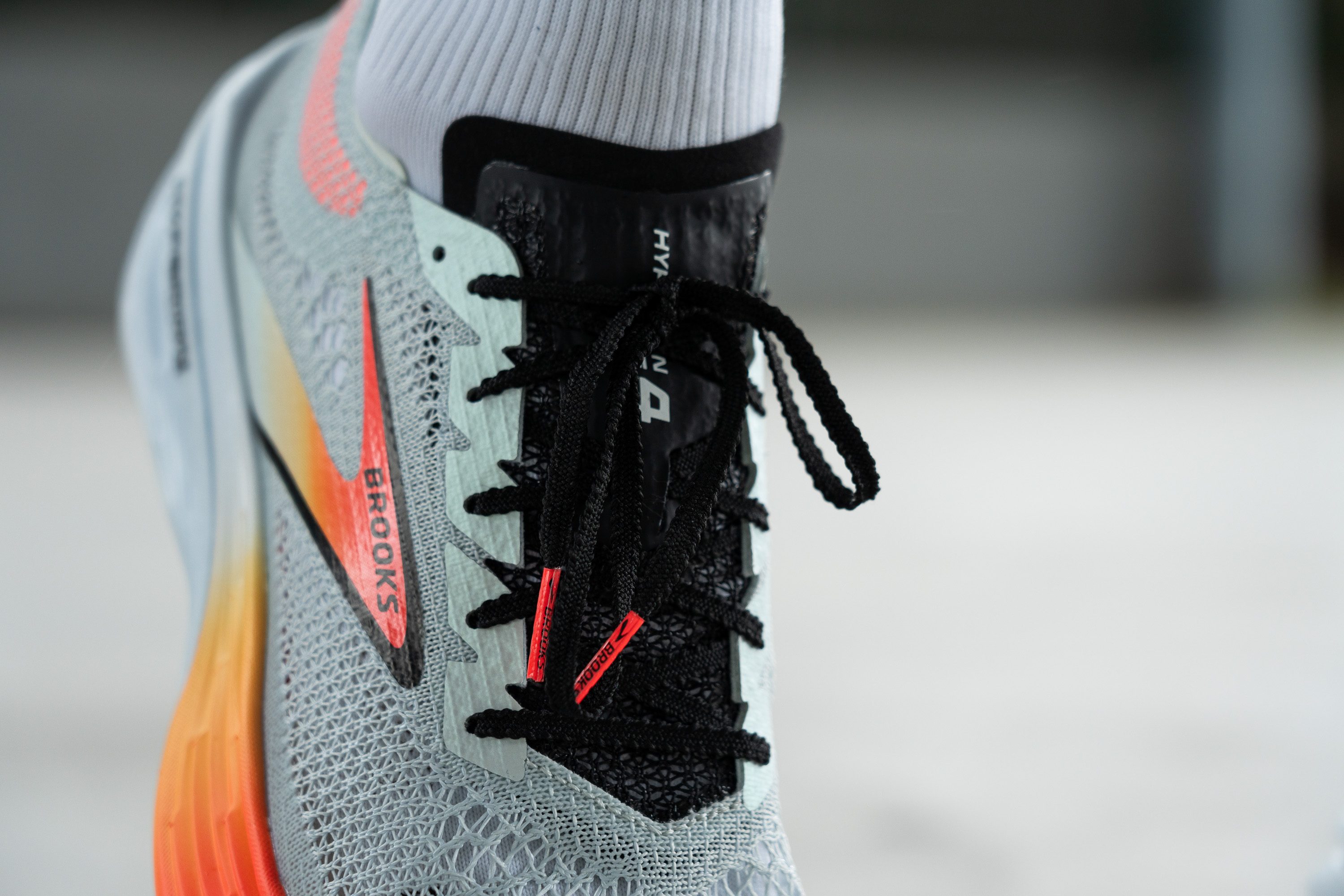
This design is a boon for runners who find the ultra-thin tongues of typical supershoes uncomfortable, particularly during marathons where tightly tied laces can cause lace bite. However, this added comfort does increase the shoe's weight slightly.
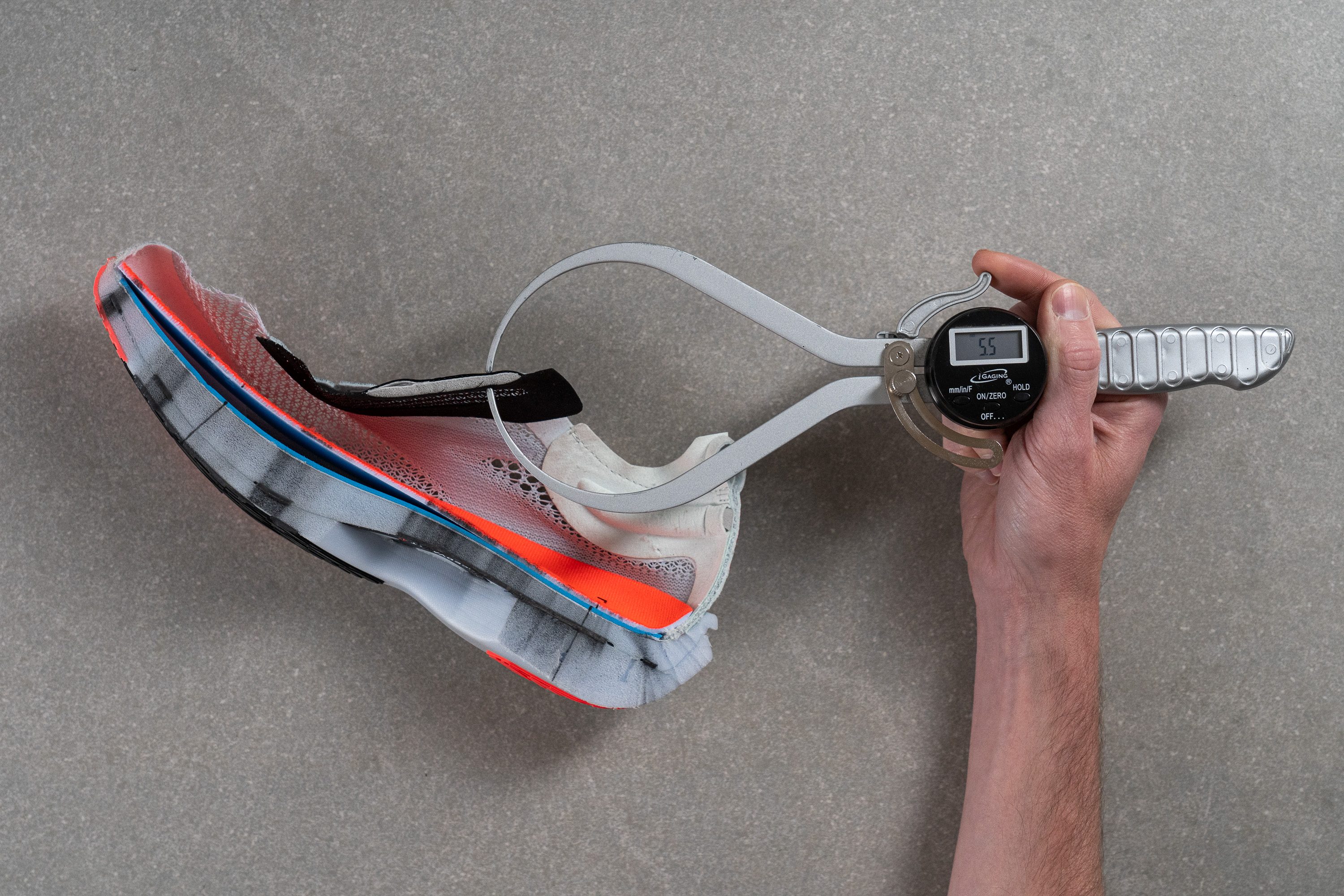
| Hyperion Elite 4 | 5.5 mm |
| Average | 5.8 mm |
Tongue: gusset type
The tongue of the HE4 is quite unique, as it's one of the few shoes we've analysed in the lab that features a one-side semi-gusseted design.
In our view, having a semi-gusseted tongue even if it's only in one side is preferable to a non-gusseted one, particularly since tongues tend to shift toward the arch rather than the outer part of the foot.
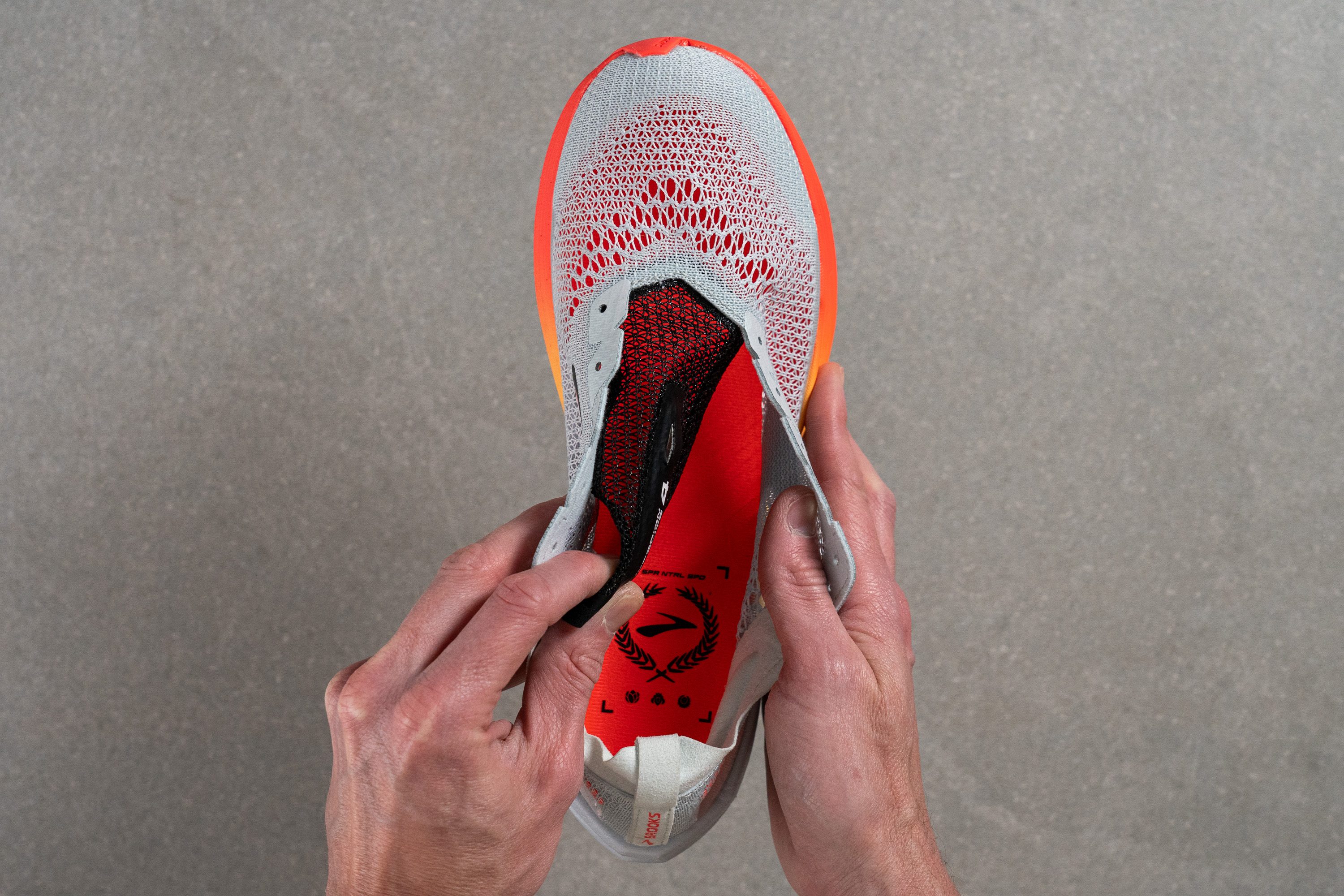
| Hyperion Elite 4 | One side (semi) |
Heel tab
Unlike other Brooks daily trainers such as the Ghost 15 or Adrenaline GTS 23, the Hyperion Elite 4 includes a handy finger-loop heel tab. It appears that Brooks recognised the challenge of slipping into this shoe compared to its more standard models and added this useful feature.
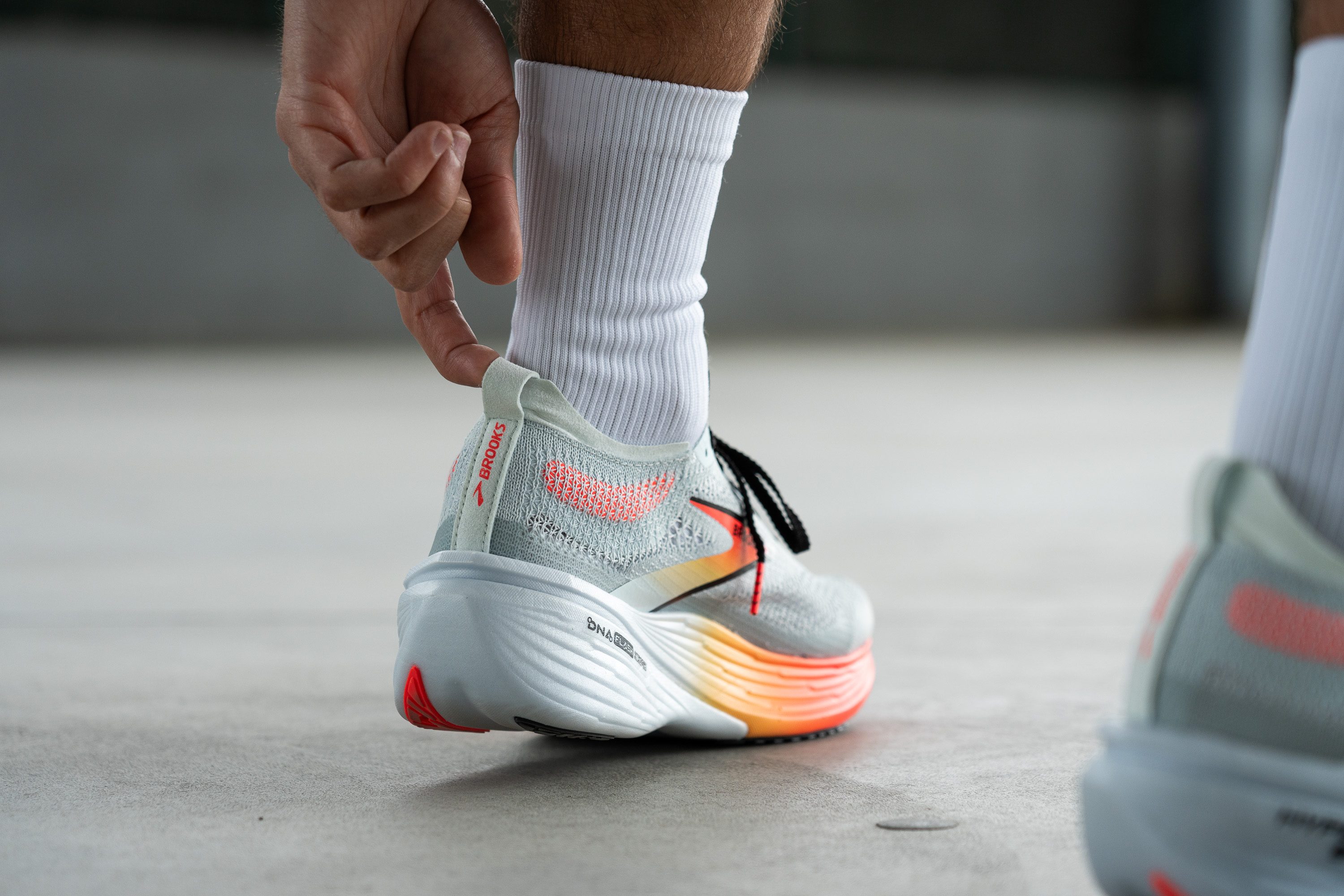
| Hyperion Elite 4 | Finger loop |

